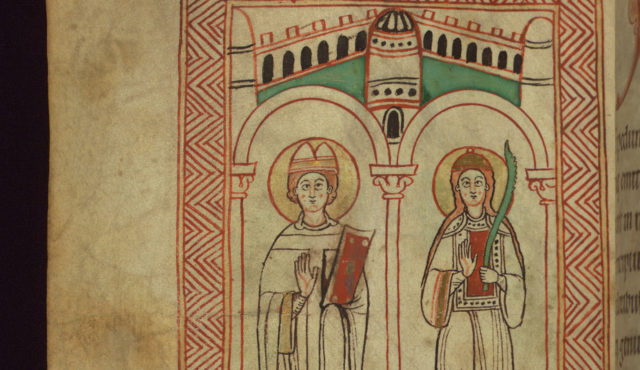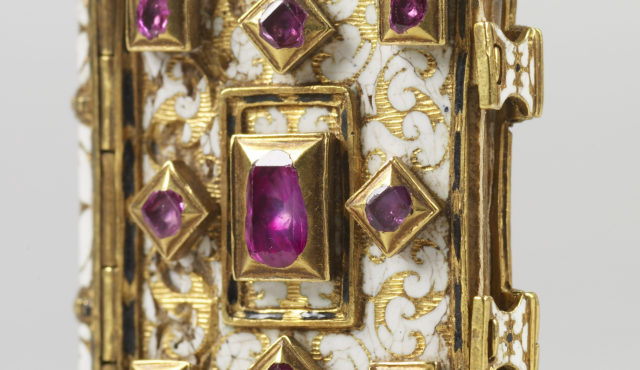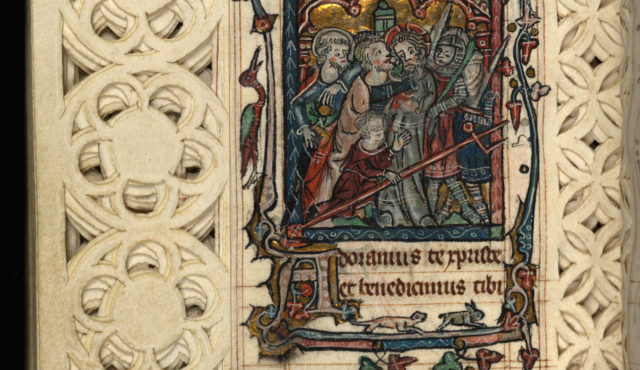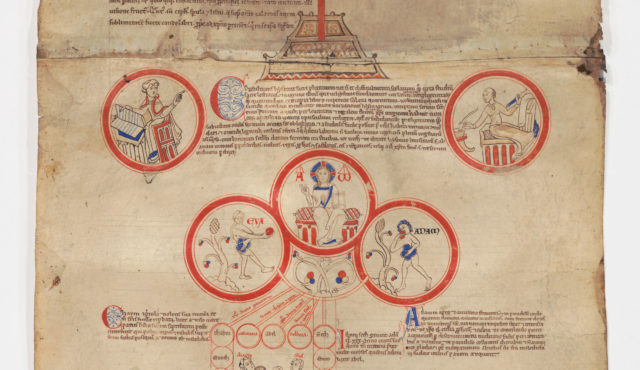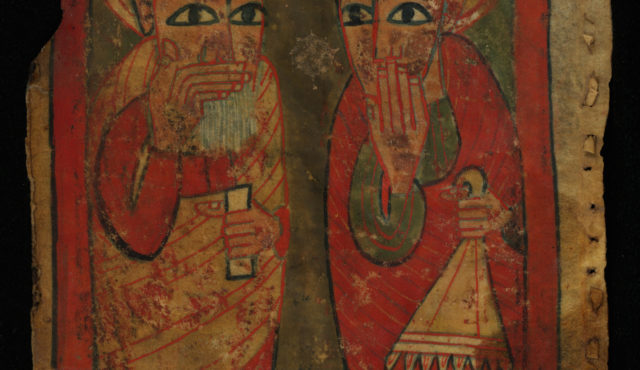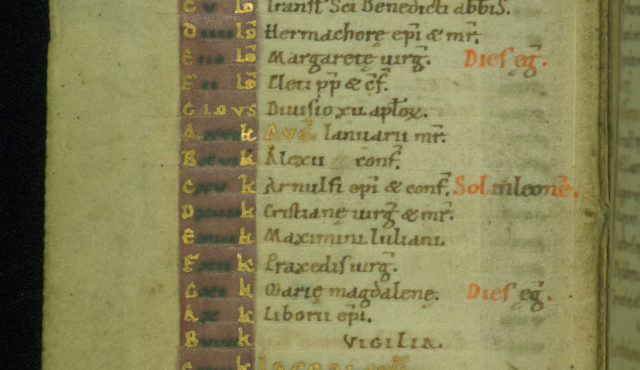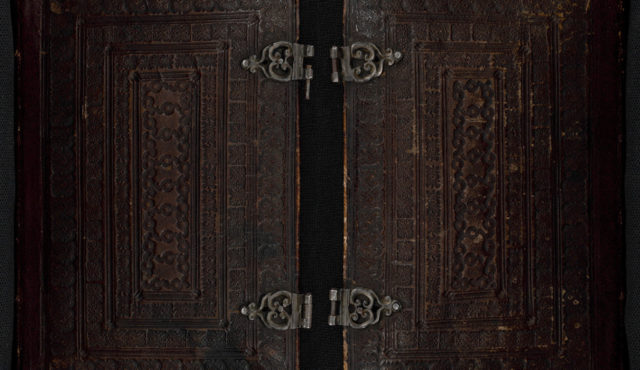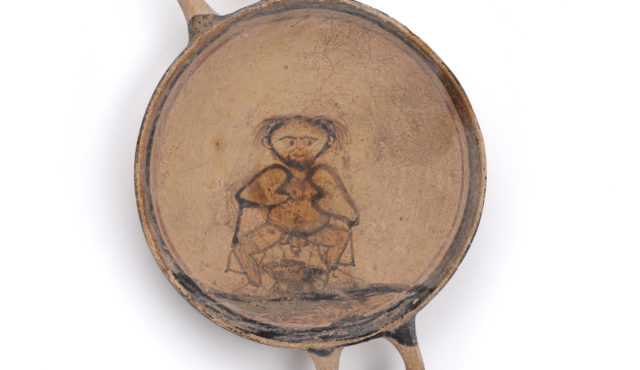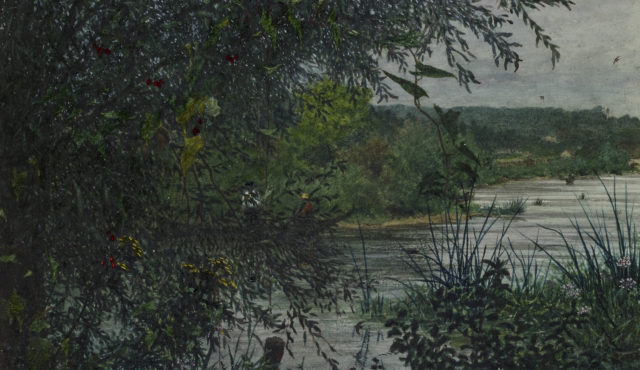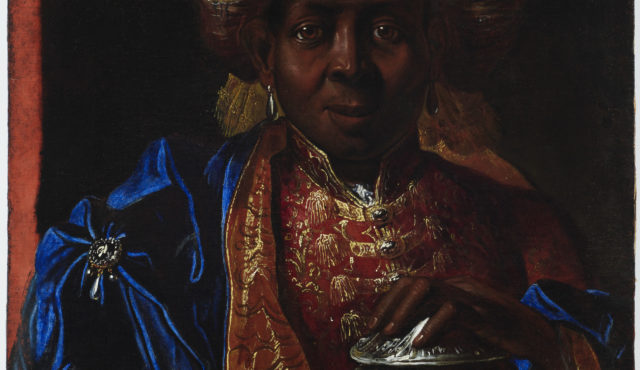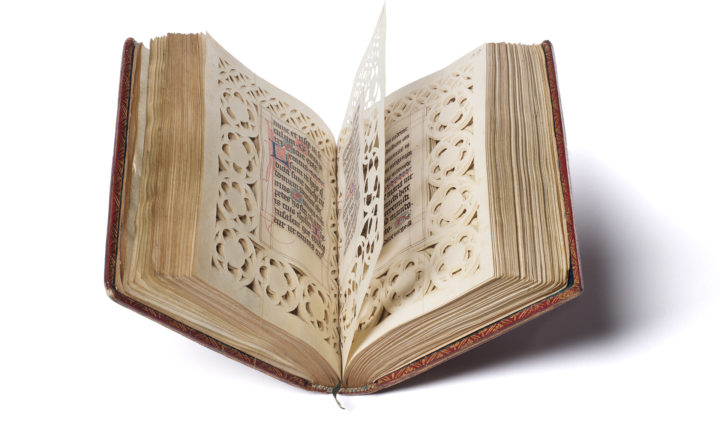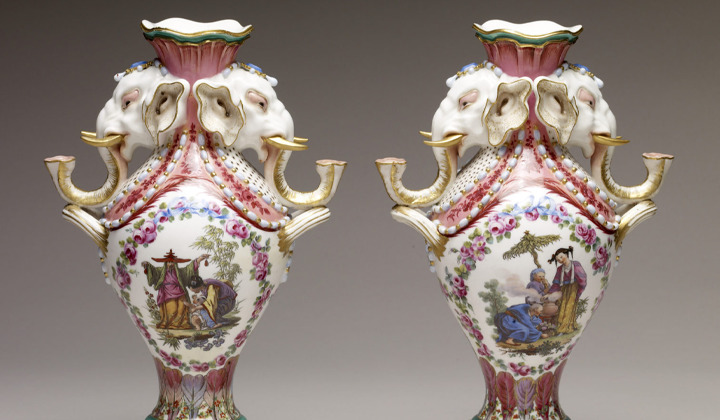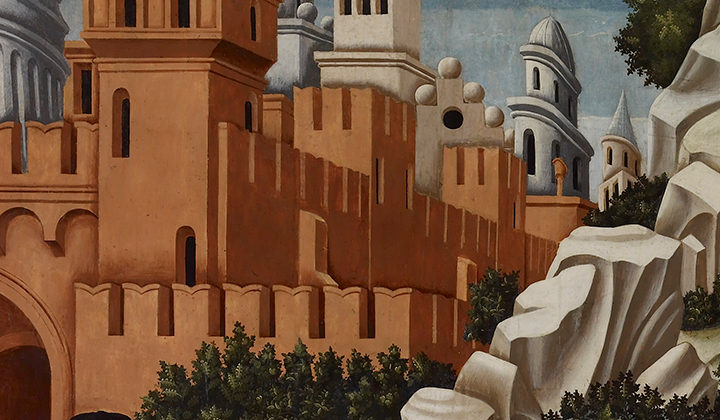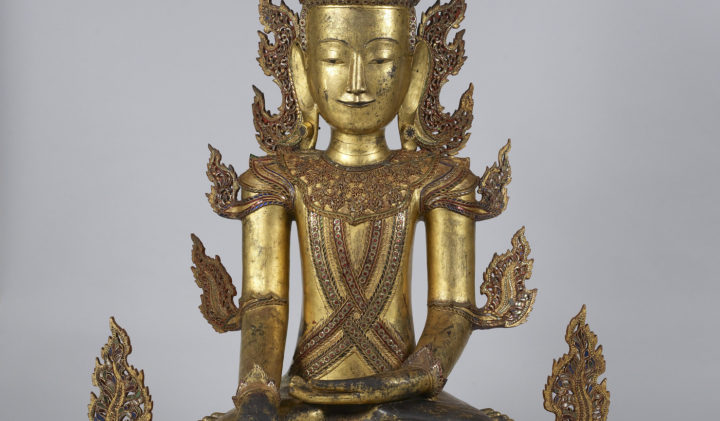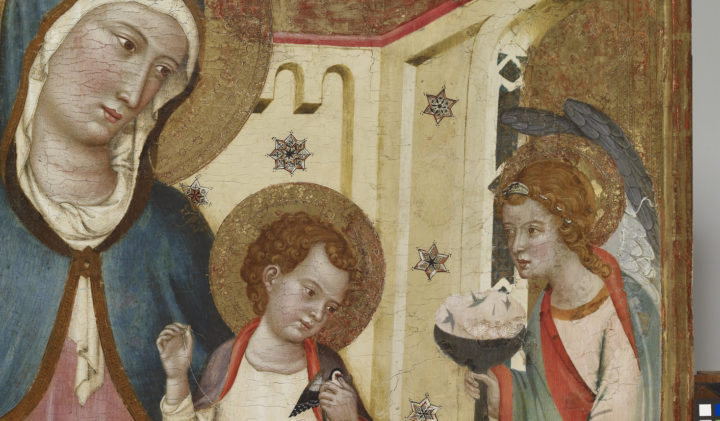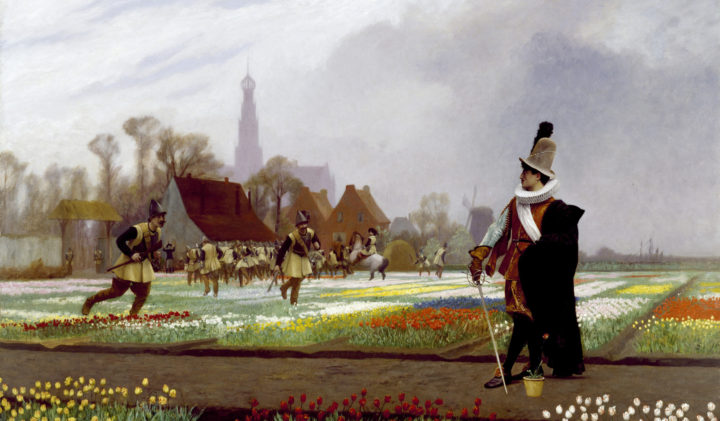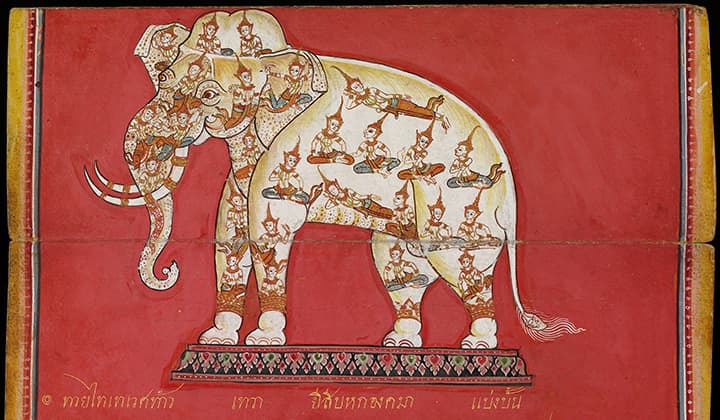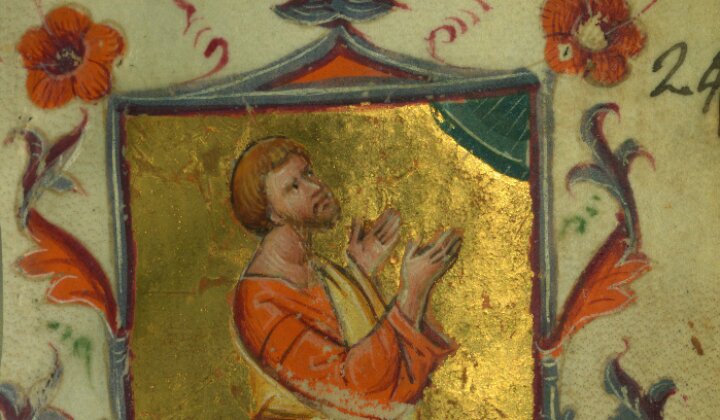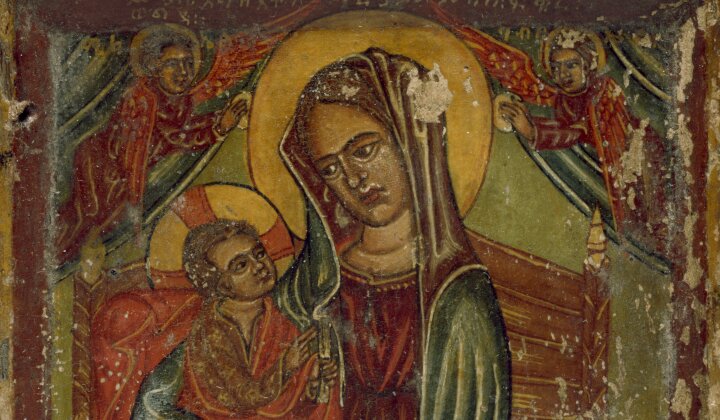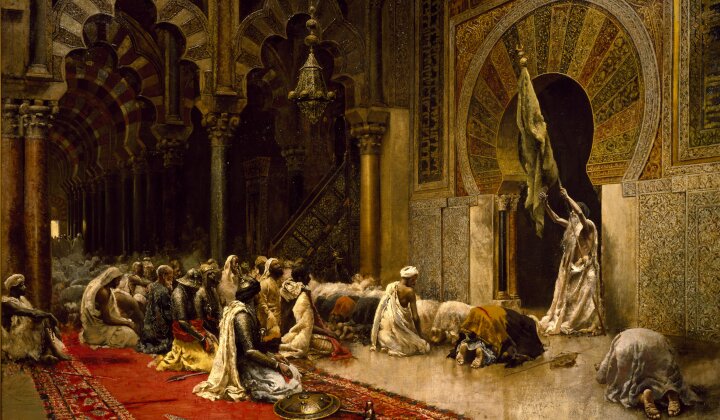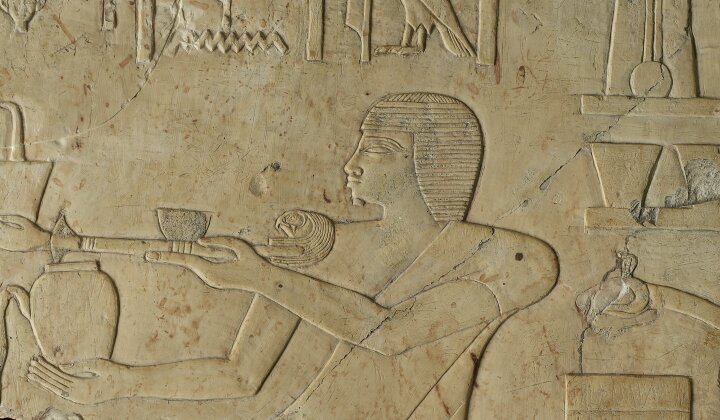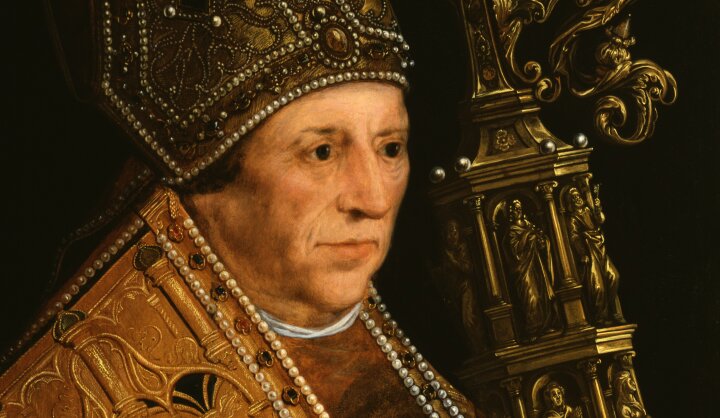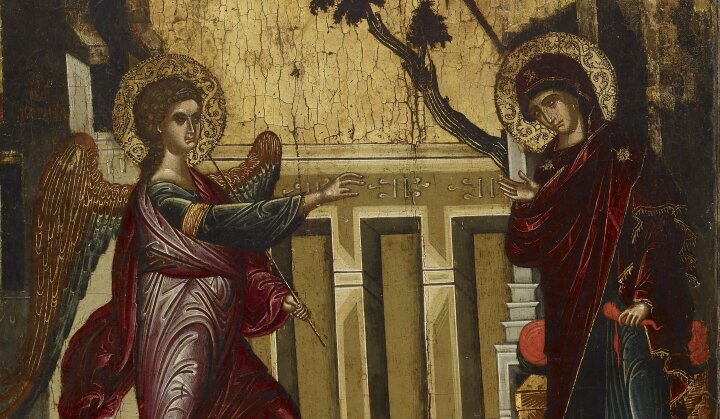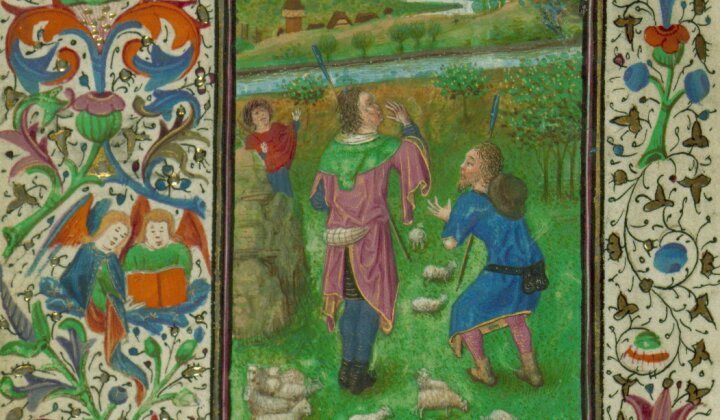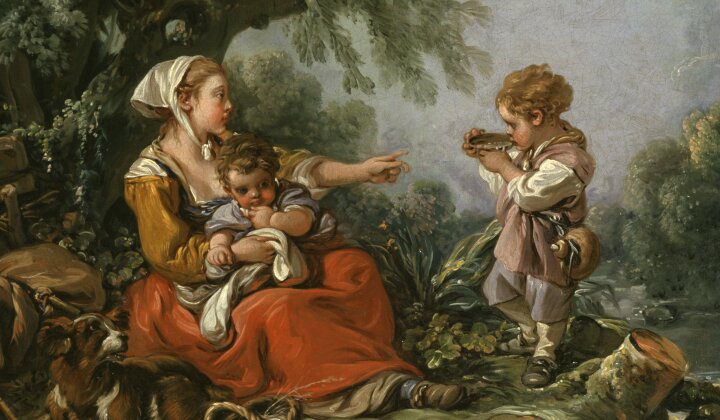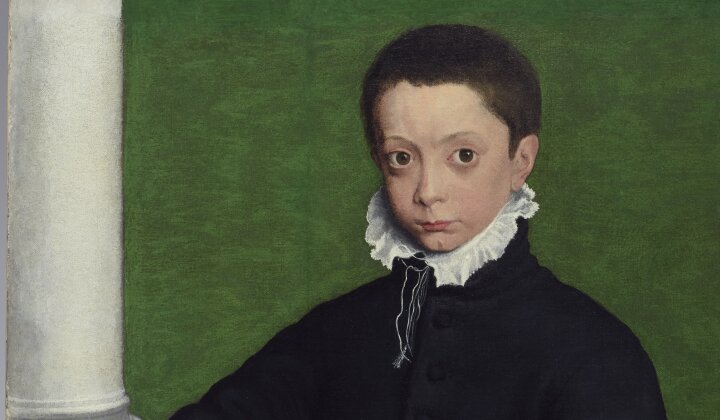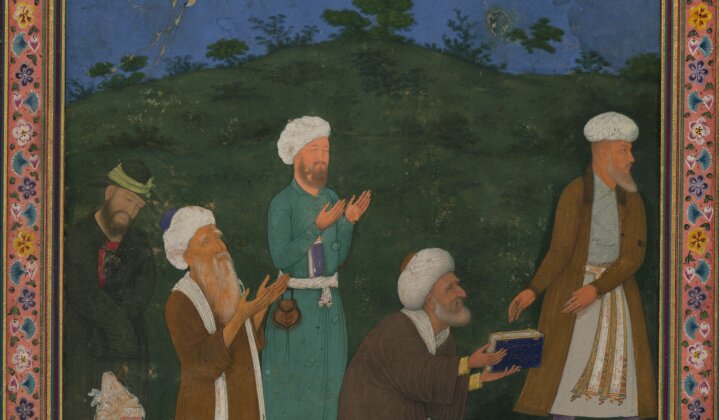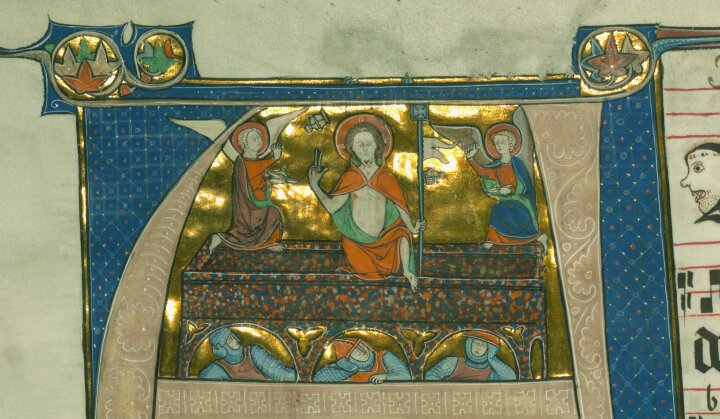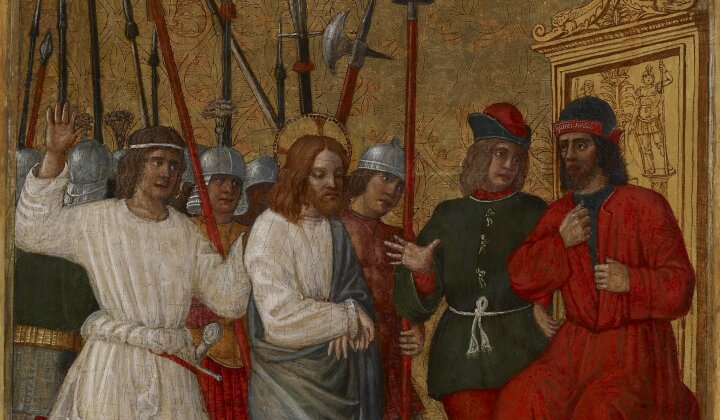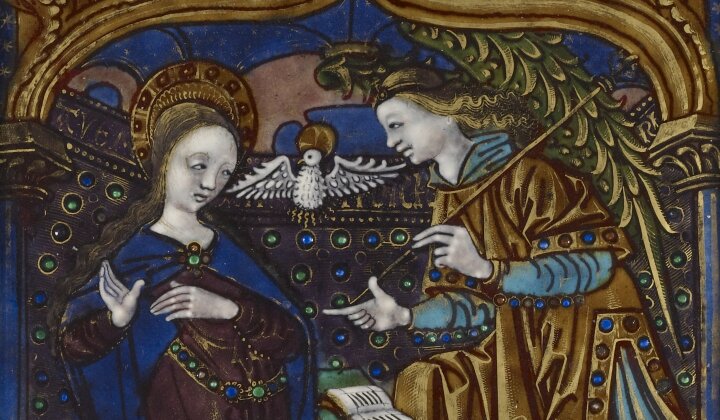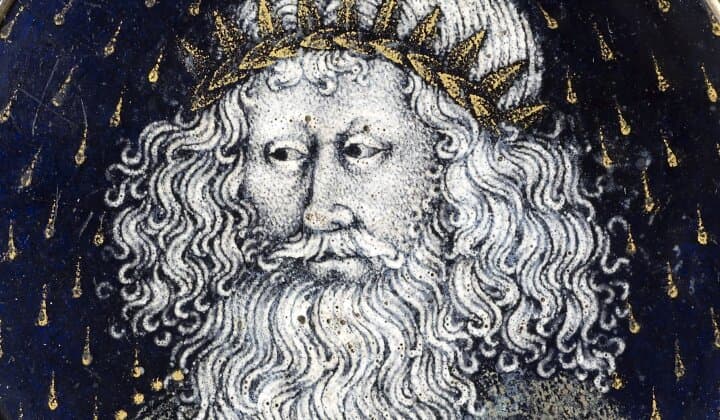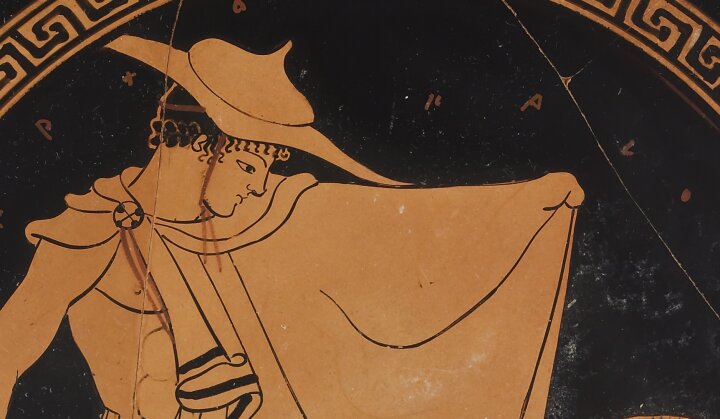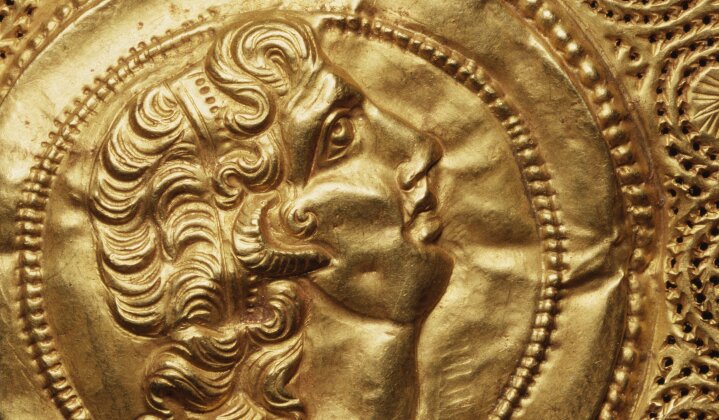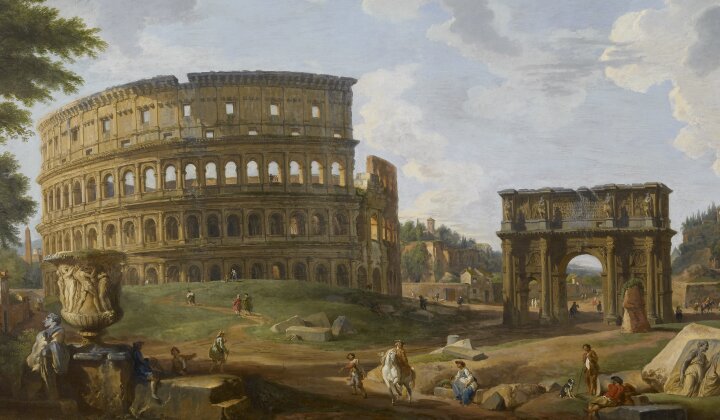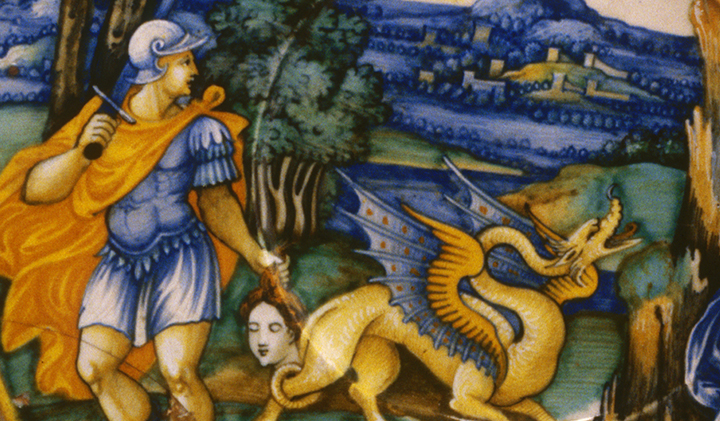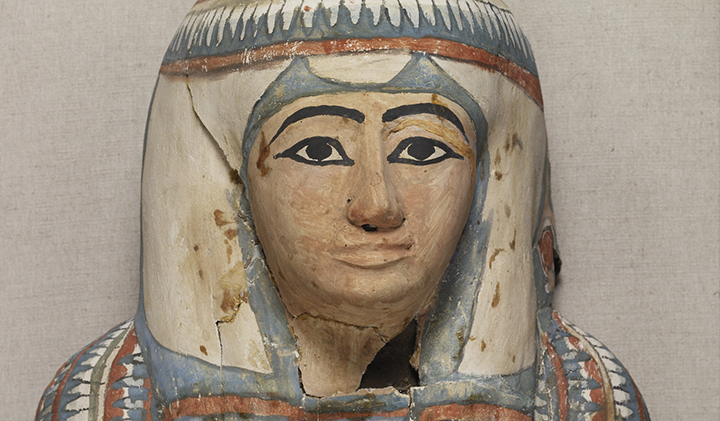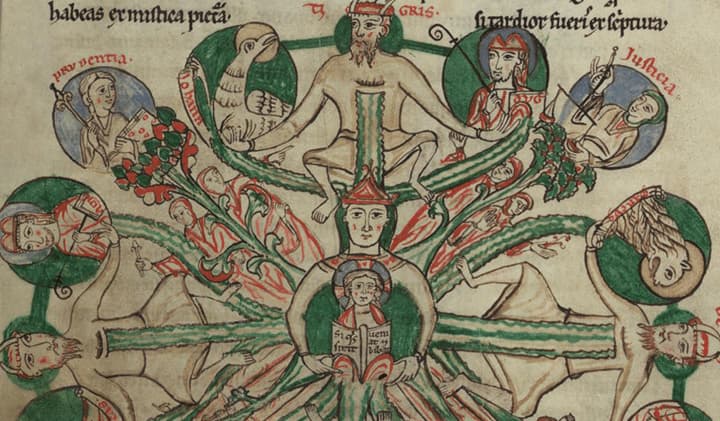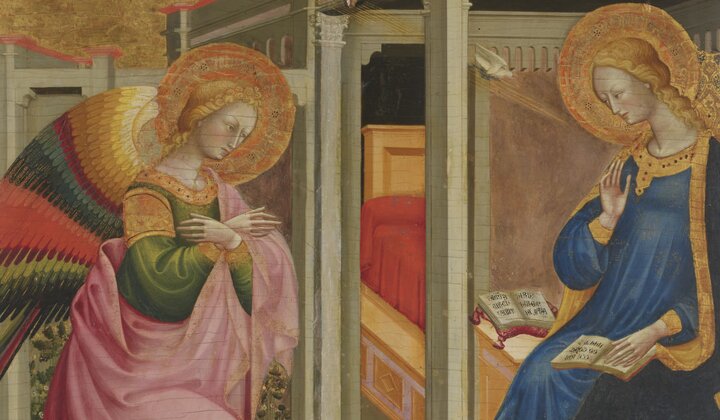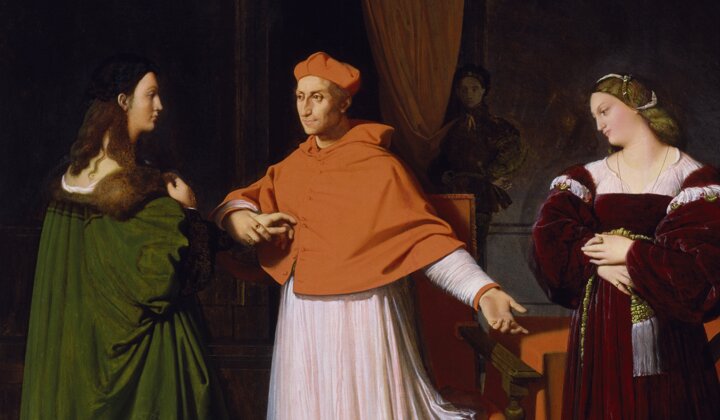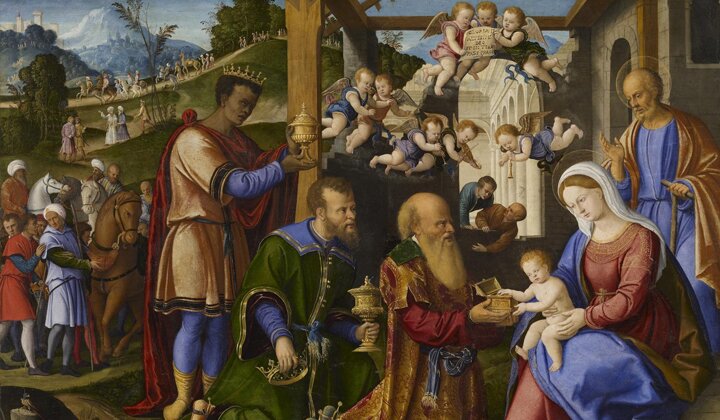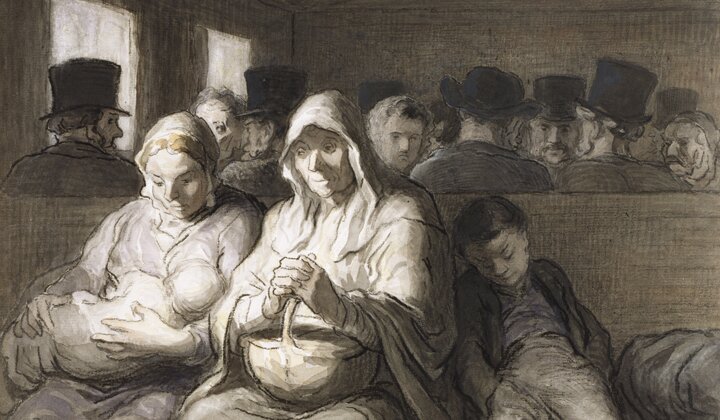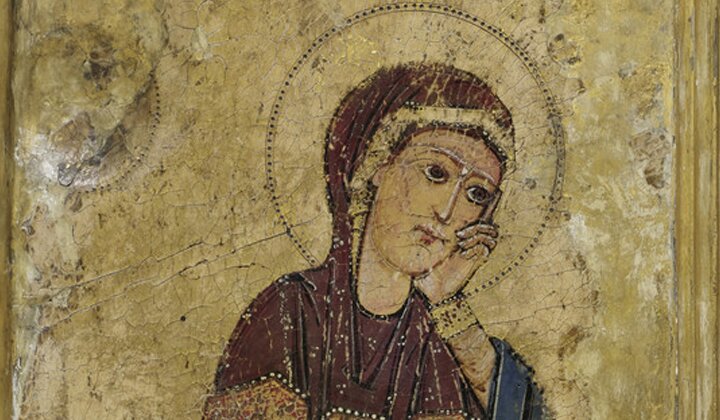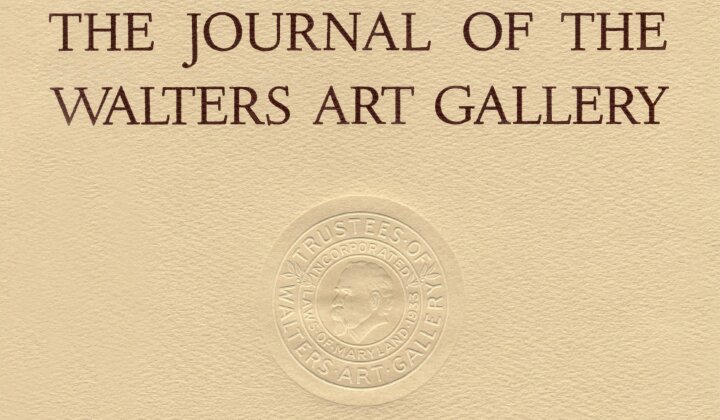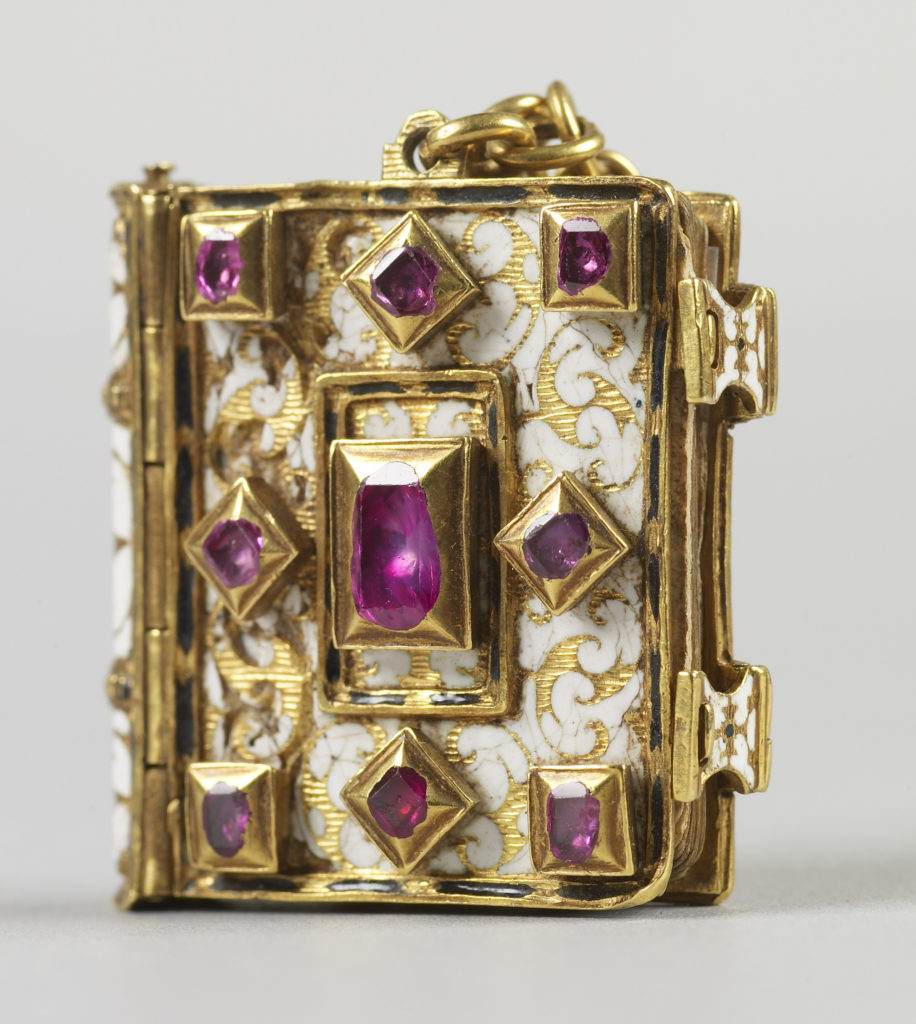
Miniatures: in the style of Giulio Romano (Italian 1515–1560) and Goldsmith: Unknown Italian artist, Miniature Manuscript Used as a Pendant, Italy, ca. 1550, ink and paint on parchment, bound between gold, enamel, and rubies (or spinels). The Walters Art Museum, acquired by Henry Walters between 1895 and 1931, acc. no. W.444
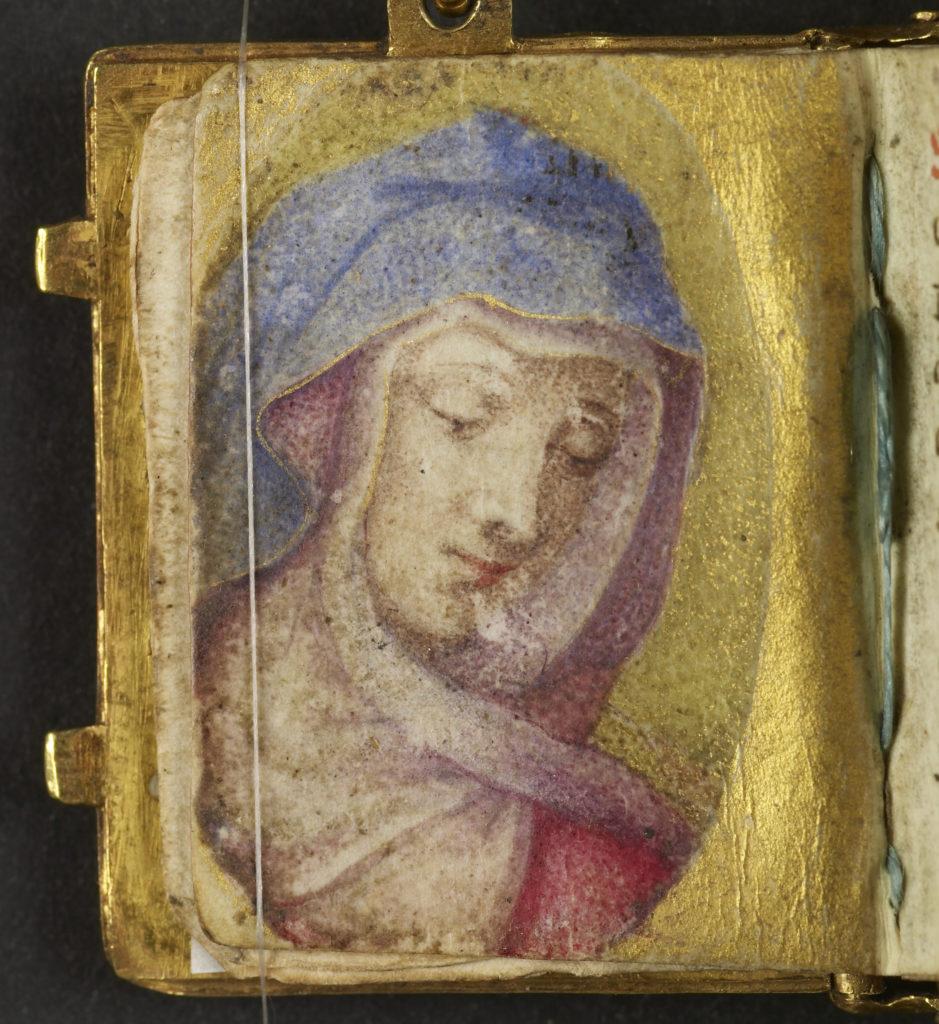
Style of Giulio Romano (Italian 1515–1560), Portrait of the Virgin Mary, Miniature Manuscript Used as a Pendant, acc. no. W.444
A diminutive, impossibly precious gold- and enamel-encrusted manuscript in the collections of the Walters Art Museum (fig. 1) reminds us that even the most outwardly resplendent books are often intensely personal. The pendant-book, judged as jewelry from the outside, is all about contrition on the inside. It contains the seven penitential psalms in Latin and two illuminations: matching portraits of Christ and the Virgin Mary (figs. 2, 3), which bookend the text. There is an obvious devotional utility to such an arrangement: the user can triangulate between intercessor and savior while activating the book through reading, perhaps aloud.[1] Supplied with a chain to keep it always close at hand, this tiny, portable guide (known as a vade-mecum) is a religious variant of the secular portrait lockets that flourished from the mid-sixteenth century onwards.[2]
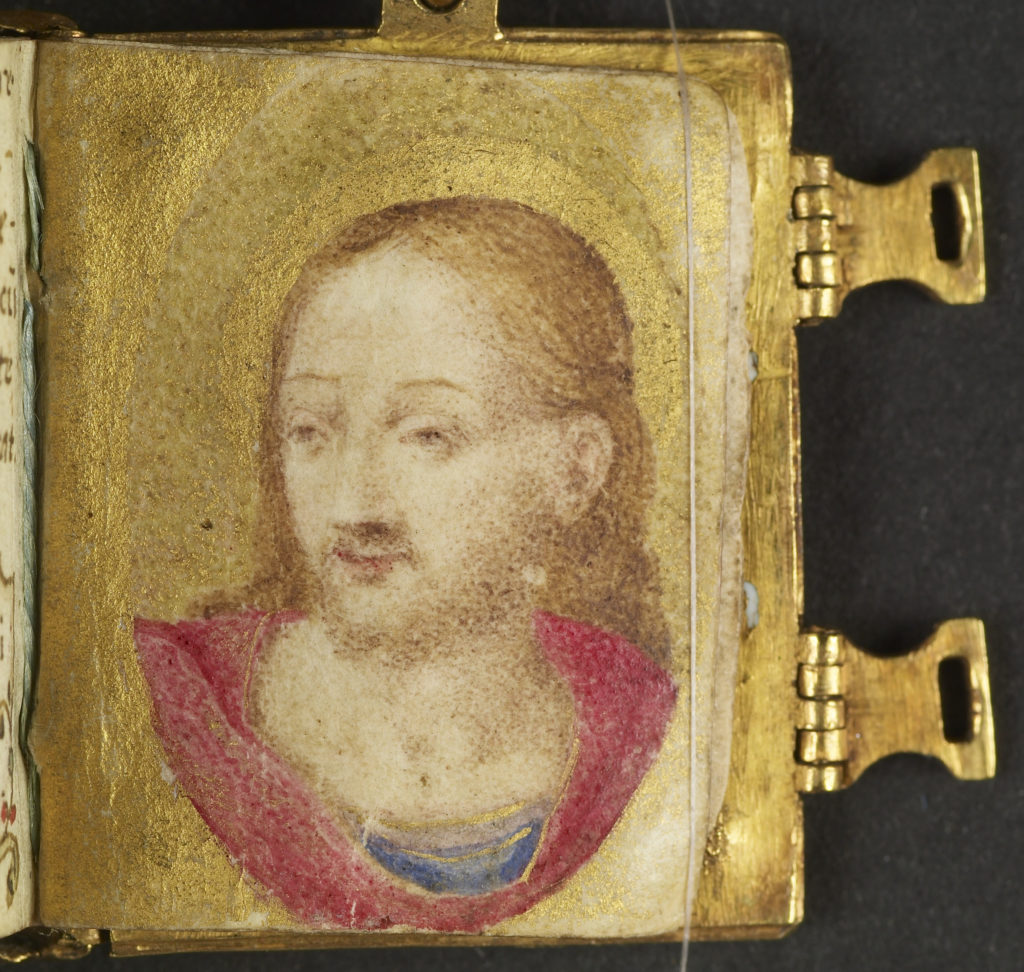
Style of Giulio Romano (Italian 1515-1560), Portrait of Christ, Miniature Manuscript Used as a Pendant, acc. no. W.444
Of course, books can be communal—processed, caged, chained to desks, and scanned by choirs—but overwhelmingly they are intended for solitary encounter rather than simultaneous use. Their popularization beyond the elites of church and state, first through devotional manuscripts and later through the propagation of print editions, is often correlated with the very genesis of supposedly modern notions of the interior life of the reader. It is not surprising that metaphors of the book as a vessel of one’s own inner thoughts abound in the later middle ages: “Dedans mon livre de pensée,” a famous rondeau by Charles of Orléans (1394–1465), describes the heart writing a story of woe within the book of the poet’s thoughts, inscribed in illuminated tears. Closely related is the idea of the book of individual conscience, in which the virtues and vices of individuals are written down, to be revealed on the Day of Judgment. The resulting variant of Last Judgment iconography in which each naked soul sports an open book against his or her chest, fascinating though rare, is a little disappointing: none of the resurrected’s books feature readable text, only simulated script (fig. 4).[3] Nevertheless, we can read between the lines to understand the meaning: the consequences of one’s misdeeds are bound up in a hidden place, laid bare to the Creator alone at the End of Time.
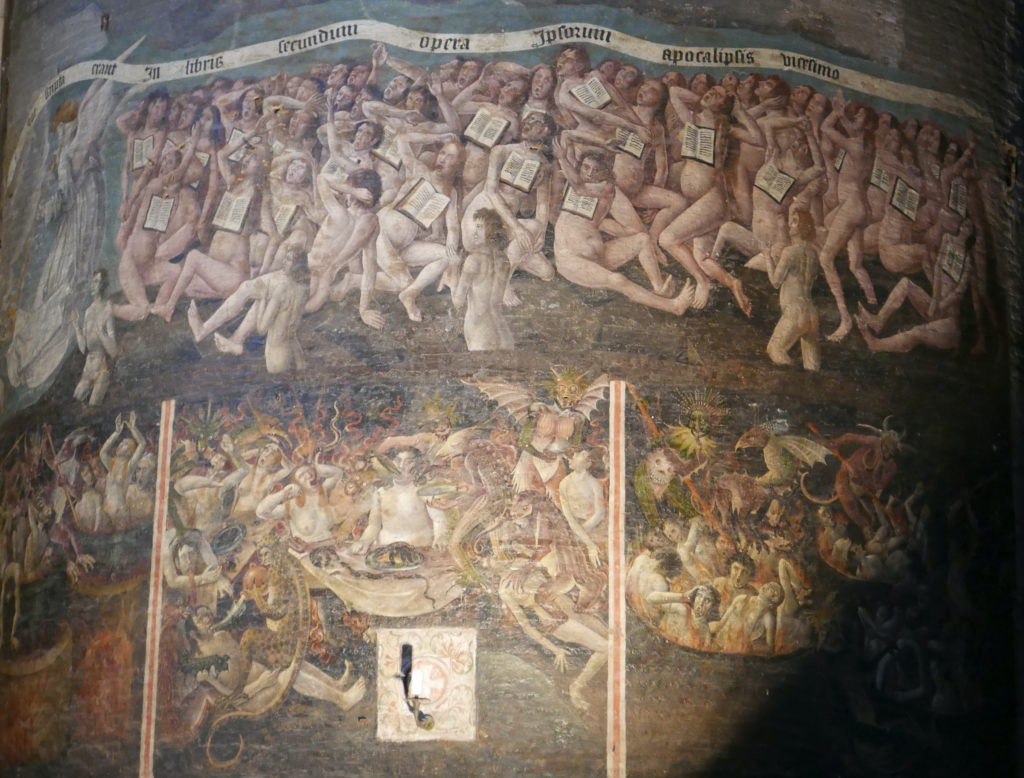
Unknown French artists, Last Judgement wall painting, Cathédrale Sainte-Cécile d’Albi, France (Albi), late fifteenth century. Image by author
But what is the interior life not of a reader, but of a closed book? What conversations might be imagined to occur within the held-fast folios of an unopened tome? How might images and texts prompt users to ponder events that could occur in their own absence, with the book left alone? To answer this, it helps to think through books—to perform mental x-radiography, stopping at the matter that resists the most. This is not a habitual methodology in Book History, nor indeed does it seem to have occurred to the vast majority of users or makers in the medieval or early modern periods, but there are at least a few instances in which books or book-like objects were crafted with the express purpose of encouraging beholders to imagine what happens between closed covers.[4] Here we shall examine a few of them.

Unknown German artists, Detail of a hole in parchment, De differentia translationis nostrae ab hebraica littera veteris testamentum, by Nicholas of Lyra (French, ca. 1270–1349) and Remigio de’ Girolami (Italian, 1235–1319), Germany, fifteenth century, ink on parchment. Free Library of Philadelphia, acc. no. Lewis E 246, fol. 134r
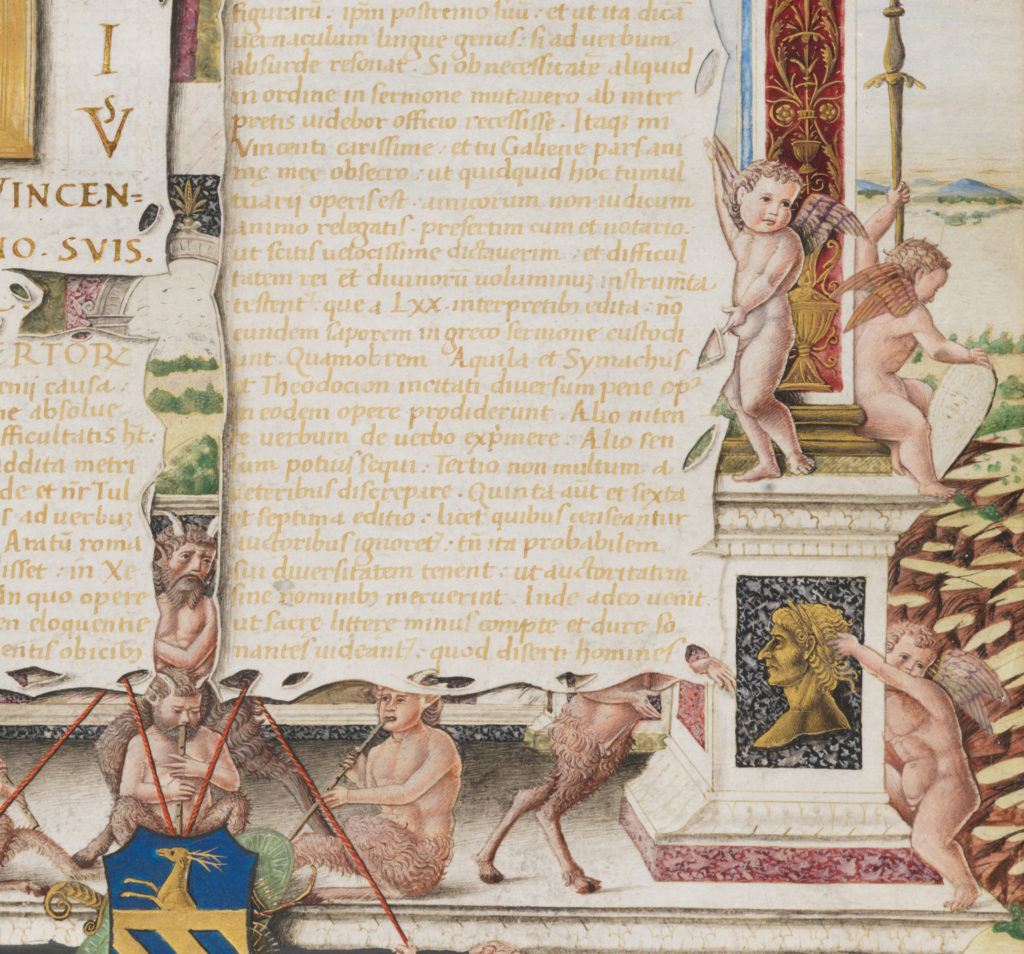
Petrus V (Italian, ca. late fifteenth century), Detail of Frontispiece from Chronicon, by Eusebius (ca. 260‒339) and translated by St. Jerome (ca. 342‒420), Italy (Padua or Venice), ca. 1480, ink and pigment on parchment. Bibliothéque publique et universitaire, Geneva, acc. no. Ms. Lat. 49, fol. 10r
The literal transversality of a closed book is inadvertently made clear by damage one frequently encounters in centuries-old books: wormholes (mostly bored through paper, not parchment), stains, and mold that mar successive folios. Prick-marks for ruling alignment, made by pin-like tools, extend through stacks of folios. Holes in parchment, the by-product of wounds in the animal skin or errors in manufacture, allow for a glimpse of the adjacent folio; they could even be cleaned up and made into more perfect shapes, like a circle, prior to the writing of the surrounding text (fig. 5). Sometimes, the “through-view” is used to frame a mischievous image or a face. Later, humanist illuminators would create elaborate manuscript frontispieces imitating perforated parchment, a comment on the crumbling condition of early medieval manuscripts that formed the basis for new Renaissance editions of classical texts (fig. 6).[5] The most extreme cases can prompt feelings of trypophobia, or the strong repulsion to irregular patterns of holes. Very occasionally, a witty illuminator could play with the trompe l’œil effect of a simulated floral marginal cutting, by making it look like it has been threaded through (simulated) slits in the page, complete with the corresponding bits of stem on the reverse side of the folio (figs. 7, 8).[6] These are virtual replicas of the curtains, pilgrim badges, and indeed actual floral specimens that were often sewn onto pages of devotional books, only to be lost over time.[7] Books with excised miniatures or folios can also have a Swiss-cheese-like appearance, but these are unusual artifacts and generally the product of more recent, commercially-motivated biblioclasm (fig. 9). Altogether, real and imagined compromises of the page allow non-sequential surfaces to touch. They get to the heart of the special, consecutive properties of the codex; holes in scrolls have more slippery, shifting foci.
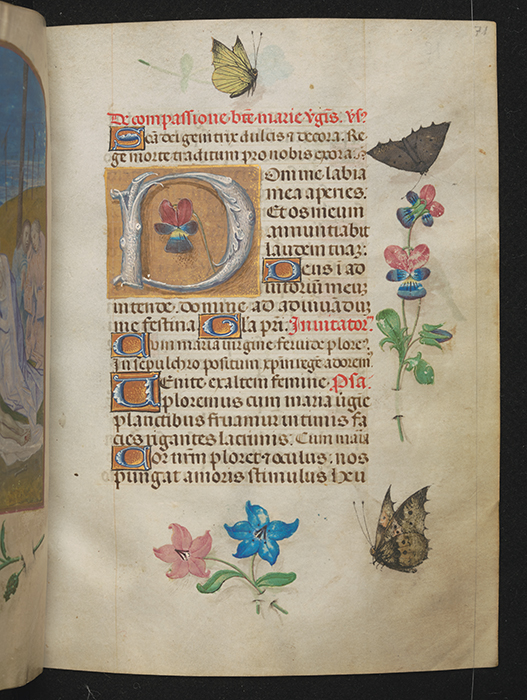
Master of the Berlin Prayer Book and Ghent Associates, Pierced strewn flower page, Book of Hours, Flanders, ca. 1483, H: 14.2 x W: 10.7 cm, ink and pigment on parchment. Czartoryski Library, Krakow, acc. no. Ms. 3025 I Rkps, p. 71
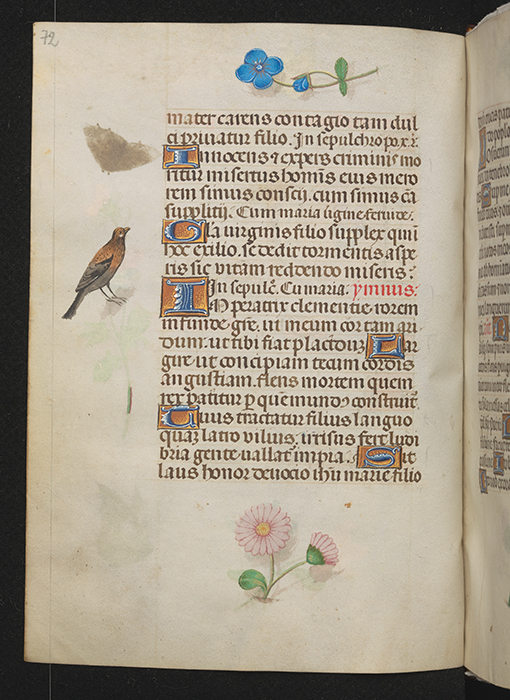
Corresponding portions of stems depicted on reverse, Book of Hours, acc. no. Ms. 3025 I Rkps, p. 72
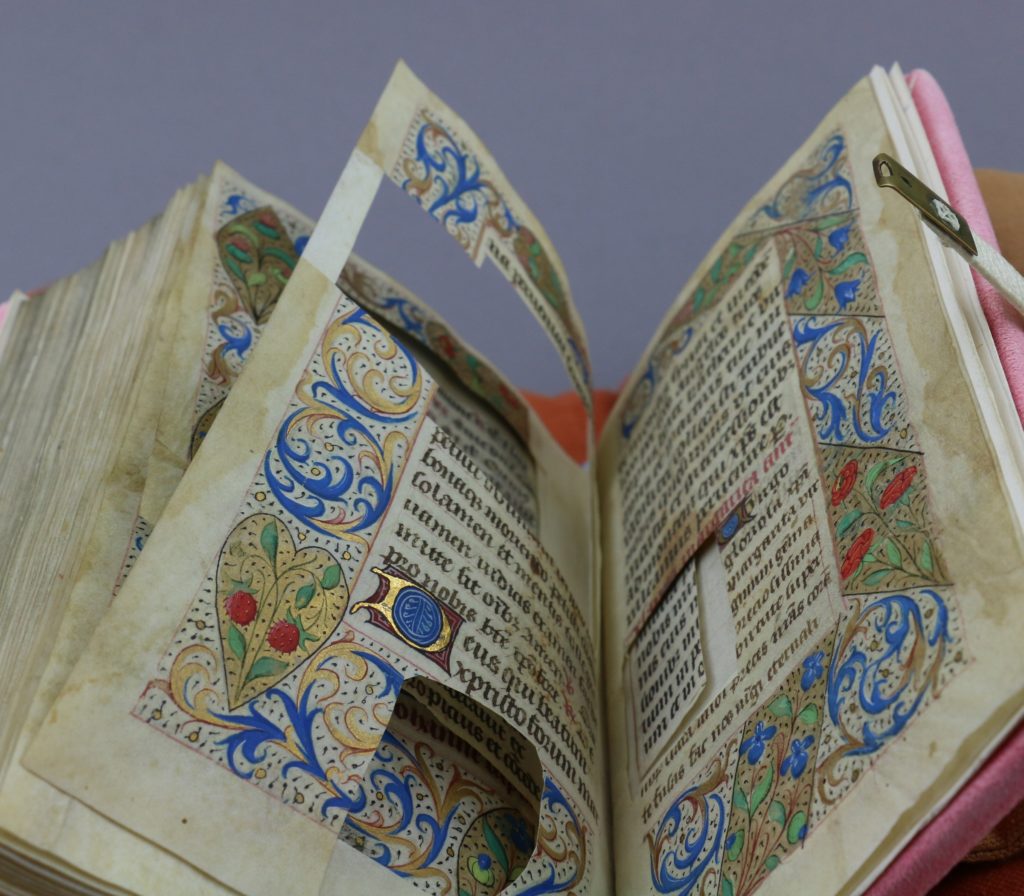
Unknown French artists, View through mutilated pages, Book of Hours, France, ca. 1475–1500, ink and pigment on parchment. University of Iowa Libraries, Iowa City, Special Collections & Archives, acc. no. MsC0542 xMMs. Bo.5. Image courtesy of Elizabeth Riordan
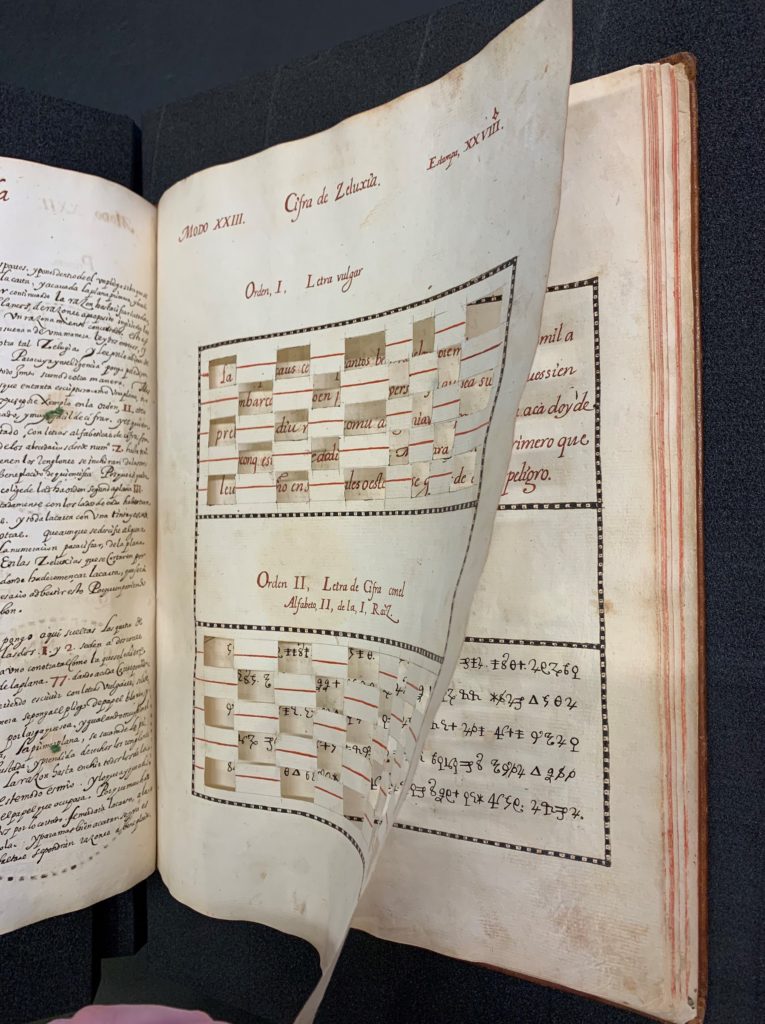
Cryptographic grille, Dos Discursos de la Cifra, Spain, ca. 1600, ink on parchment. University of Pennsylvania, Philadelphia, Kislak Center for Special Collections, Rare Books and Manuscripts, Rare Book Collection, Lawrence J. Schoenberg Collection, 2011, acc. no. LJS 423. Image by author
Philologists and bibliographers are often the last to recognize physical density. Persons as diverse as book artisans, soldiers, and religious trainees can have a more intuitive understanding of what we could call the “throughgoing-ness” of the book block. During binding, the trimming of the lateral sides of the book (head, tail, and fore-edge) with a sharp tool known as a plough is a reminder that the pre-modern book is essentially a sculptural object. A number of pocket Bibles embedded with bullets are purported to have come between soldiers and death during the American Civil War or the two World Wars; according to family lore, the seventeen-year-old World War I private Leonard Knight was saved by just fifty unpierced pages in a Bible that survives to this day.[8] The so-called “pin test,” mastered by Rabbinic scholars of the early twentieth century, involved pushing a tack through the Babylonian Talmud and correctly predicting the exact word that would be pierced on a given page.[9] More decoratively, the landscape paintings and intricately stamped goffering that can adorn the fore-edges of books traverse stacked folios that are normally considered only in sequence. Contemporary artists who sculpt books and excavate stratigraphic forms from within them, such as Brian Dettmer, work to counter the notion of the dematerialized “text,” and the digital intangibility of the present.[10]
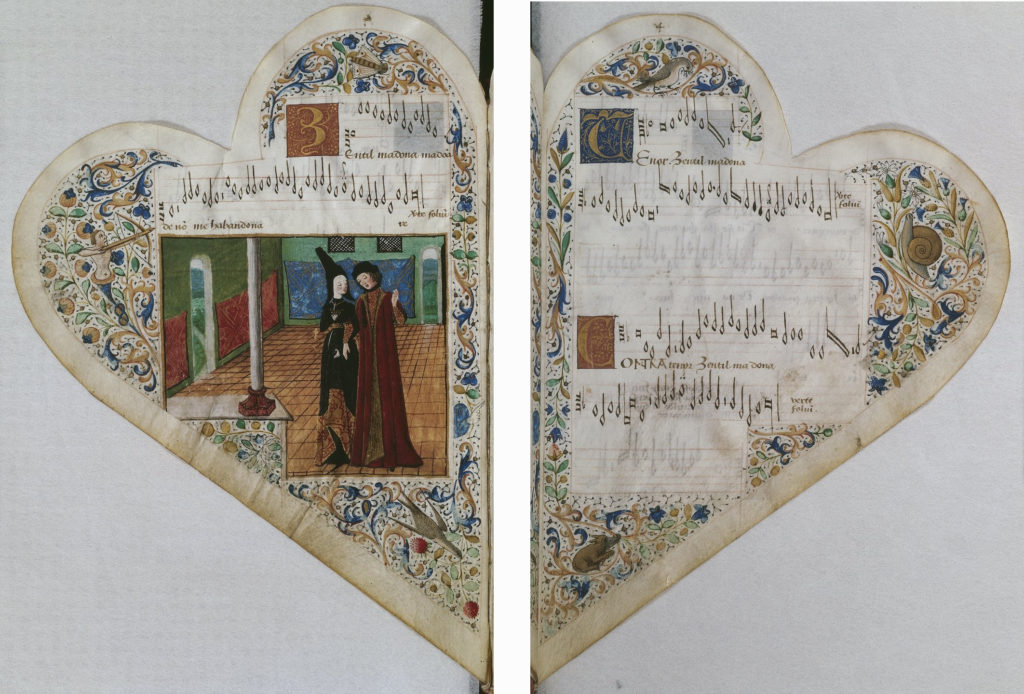
Unknown French artist, Chansonnier de Montchenu, by various authors, France, ca. 1470–1480, 22 × 16 cm (per folio), ink and pigment on parchment. Bibliothèque nationale de France, Paris, 1949, acc. no. Ms. Occ. Rothschild 2973, fols. 3v–4r
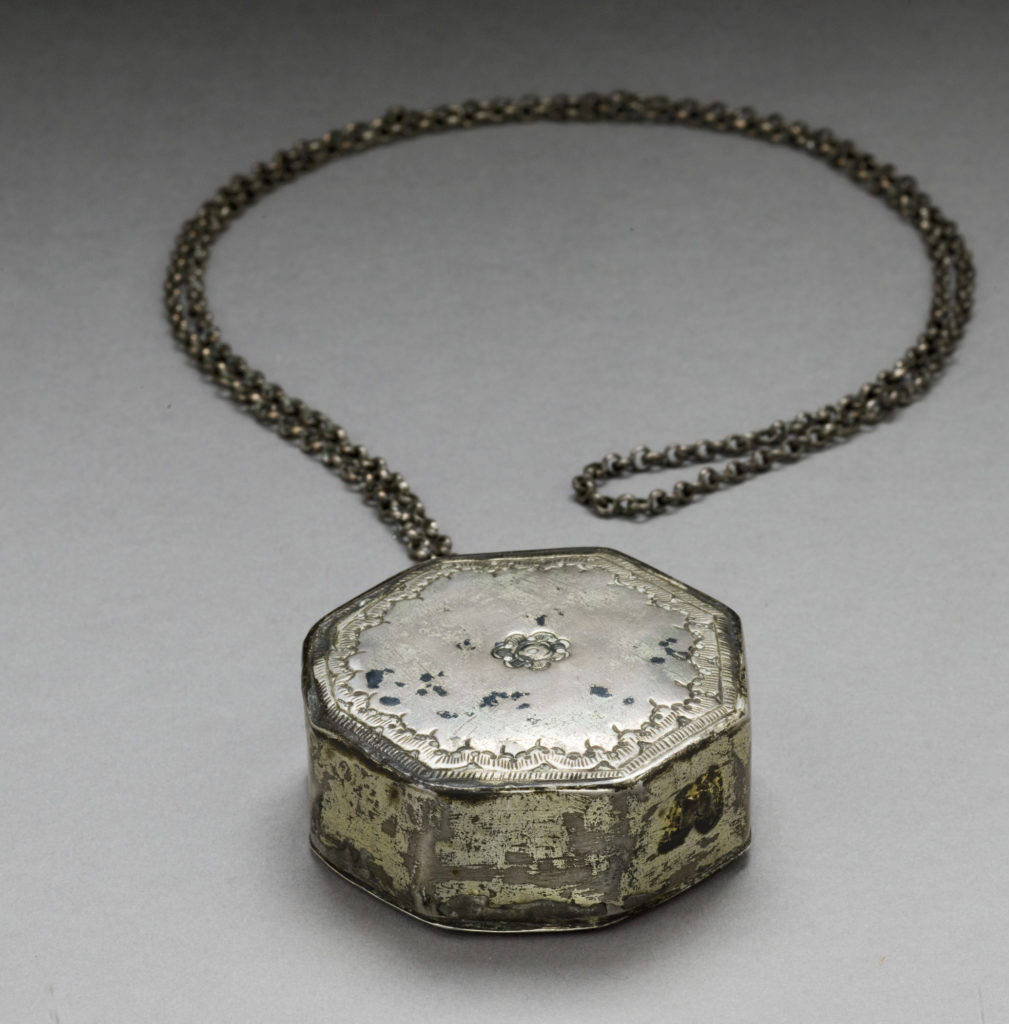
Unknown Egyptian artist, Miniature Qur’an in Silver Case with Chain, Egypt, possibly sixteenth century CE/ca. 10–11th century AH, silver, leather, ink, opaque watercolor and gold on paper. Los Angeles County Museum of Art, anonymous gift, acc. no. M.91.364.43
Vanishingly few late-medieval manuscripts are sculpted on the inside, but an exceptional clutch contains purposeful perforations, pierced over many successive folios, that aerate their interiors to astonishing effect. The effect is reminiscent of but functionally very different from early-seventeenth-century cypher books that use perforated grids known as grilles to selectively block sections of a page of text to reveal a secret message within it (fig. 10).[11] This plaintext cryptographic method, developed by the Lombard polymath Gerolamo Cardano, usually consists of a single page overlay.[12] The earlier, more extensively disemboweled books are the more earnest precursors to those unfortunate books later transformed with glue and knife into cigarette cases and other hidden boxes, a mostly post-Victorian novelty;[13] they allow one to wonder what goes on inside. The practice is related to those rare circle-, heart-, or fleur-de-lys-shaped books, like the Chansonnier de Montchenu (fig. 11),[14] or indeed the numerous octagonal Korans used as pendants (fig. 12), reminiscent of the bejeweled Christian prayer book discussed above.[15] These exceptions to the silver ratio (1:√2), which usually governs a page’s rectangular width-to-height proportions, throw the hegemony of standard formats into question, but they do not really compromise the interior of the page, or allow one to imagine strange voids within. One breathtakingly unique specimen at the Walters Art Museum (fig. 13), subject of a separate study in this volume by Lynley Anne Herbert, is a fourteenth-century Book of Hours whose 148 folios are each exquisitely cut with matching cusped Gothic tracery motifs; handling the book is like flipping through a stack of doilies, though much more unnerving. While the feature was once dismissed as a later alteration, close study by Herbert and manuscripts conservator Abigail Quandt has revealed that the honeycomb-like cuts are original, since they are overlapped by ink and paint. While it is impossible to know for sure, such a practice could once have been more common, with other fragile examples having been lost to damage. Centuries later, the cut-out technique, known by the French term canivet, would become popular as a way of ornamenting single-sheet items, or, as in the case of a Walters manuscript associated with Marie de Medici (fig. 14), an entire volume.[16]
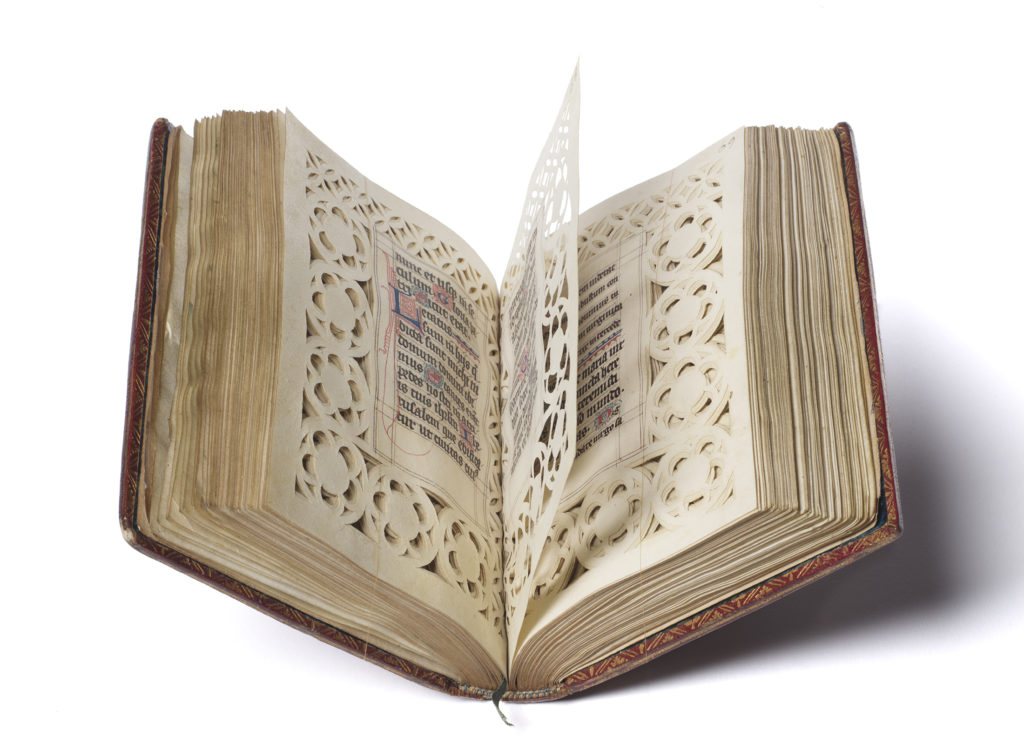
Fig. 13 Unknown French artists, Opening with “lace” borders, De Bar Hours, Northeast France (Lorraine), ca. 1310, ink and pigment on parchment. The Walters Art Museum, Baltimore, acquired by Henry Walters, by 1931, acc. no. W.93

Unknown French Artist, Lace Book of Marie de’ Medici, second quarter seventeenth century (with several added fifteenth century miniatures), ink and paint on parchment. The Walters Art Museum, Baltimore, acquired by Henry Walters, by 1931, acc. no. W.494, fol. 5r
A pair of peerless Books of Hours with illuminations by the French Renaissance painter Jean Poyer (circa 1445–1503) have purposefully excised centers that are bound up with the meaning of the surrounding texts and images. One of these, now in Copenhagen, contains a total of sixteen lozenge-shaped miniatures centered within two columns of text, which remain visible as the reader turns the interstitial pages, pierced as they are with perfectly aligned rhomboid openings (fig. 15). The book begins with an unbroken calendar, but following this comes a succession of scenes, beginning with Saint John on Patmos, that remain visible on the verso side of the opening through several successive folios, just as a corresponding image visible on the right-hand, recto side is brought nearer and nearer as more pages are turned, until that page is reached, overturned, and the next set of facing miniatures revealed. Sets of decorative triangular spandrels, whose patterns never repeat, frame the lozenge-shaped hole in each page, though the layout of the book as a whole was clearly experimental, as there are sections where the text finishes several folios before the miniature is reached as well as empty frames devoid of miniatures. Of the completed miniature pairings in the Copenhagen Hours, four are standalone scenes that don’t explicitly address the iconographies they face, including the Saint John and Virgin and Child, who each face outward from the gutter. Three—the Annunciation, David and Bathsheba (fig. 16), and Job Mocked by His Friends—are enacted as pendants across the spread or, more accurately, through the opening. A final pairing shows the Trinity as Throne of Wisdom on the left, and the assembled apostles on the right. This could also be construed as two halves of a single evocation of Pentecost.
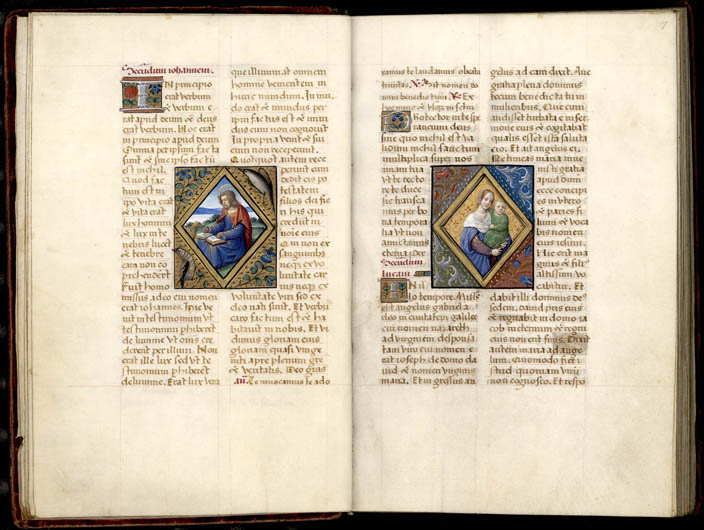
Jean Poyer (French, ca. 1445–1503), Miniatures of Saint John on Patmos and the Virgin and Child, Copenhagen Hours, France (Tours), ca. 1490–1500, H: 26 x W: 17 cm (per folio). Kongelige Bibliotek, Copenhagen, acc. no. Ms. Thott 541 4°, fols. 6v–7r (Virgin and Child on fol. 14r)
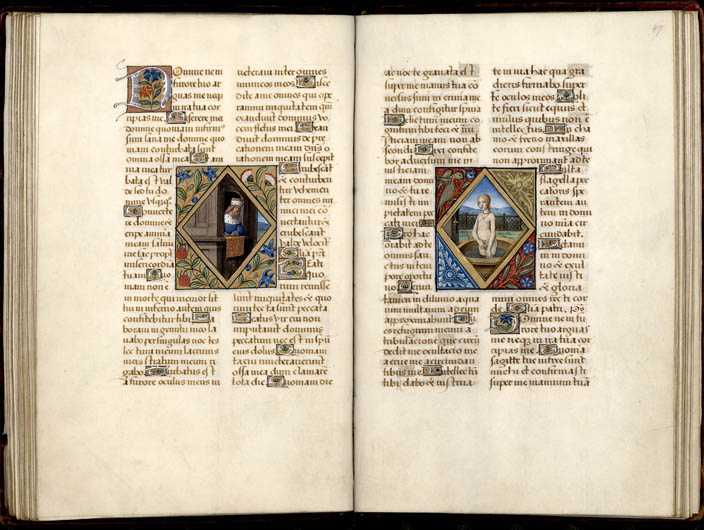
Jean Poyer, Miniatures of King David and Bathsheba, Copenhagen Hours, Kongelige Bibliotek, acc. no. Ms. Thott 541 4°, fols. 46v–47r
(Bathsheba on fol. 53r)
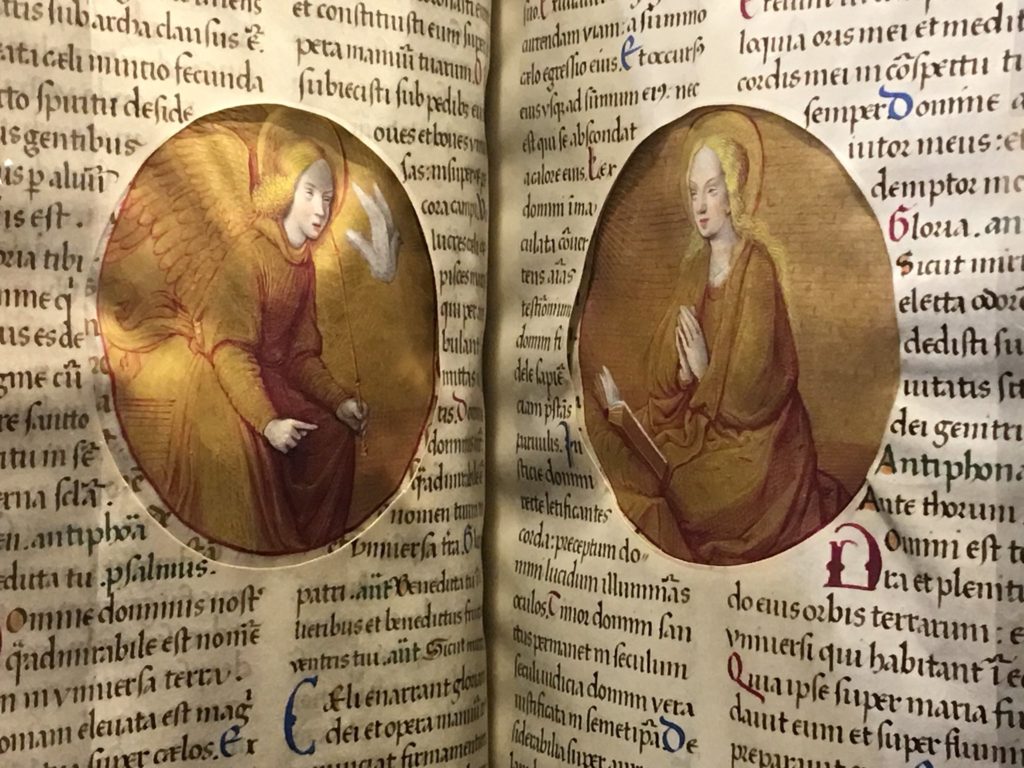
Jean Poyer (French, ca. 1445–1503), Miniatures of Gabriel and the Virgin Annunciate, Petau Hours, France (Tours), ca. 1490–1500. Private collection, fols. 8v–9r. Image courtesy of Elliot Adam
The other Poyer work, the Petau Hours, so-named after a later owner and today in a private collection, employs the same conceit but with round openings (fig. 17). However, apart from its Gabriel-Virgin Annunciation pair and perhaps the quartered medallion of the Evangelists (fol. 4v) that face their zoomorphic symbols (fol. 7r) across two folios worth of open roundels, the remainder of the facing medallions in the Petau Hours consists of standalone images that do not immediately relate to their partners. Frank O. Büttner and, more recently, Rostislav Tumanov and Elina Gertsman, have sensitively discussed the user’s experience in navigating these exceptional books.[17] What these authors do not necessarily contend with is the focused channeling of gazes not outwards towards the viewer, but between figures as the books are closed. The many intervening “peepholes” are superimposed to create deep interior window wells that give space to the painted interlocutors to converse at the heart of the closed book. While the user is party to David’s espying of Bathsheba, the act of opening the book gives an acute sense of having barged in on a voyeuristic moment. The result is a kind of zooming-in on the continuous double-page illustration that was increasingly popular at the time (especially for Annunciations; fig. 18). If the above-mentioned sixteenth-century cypher grilles allowed users to block out the irrelevant cryptographic noise and focus on the correct meaning, here the unique layout cuts to the chase visually.
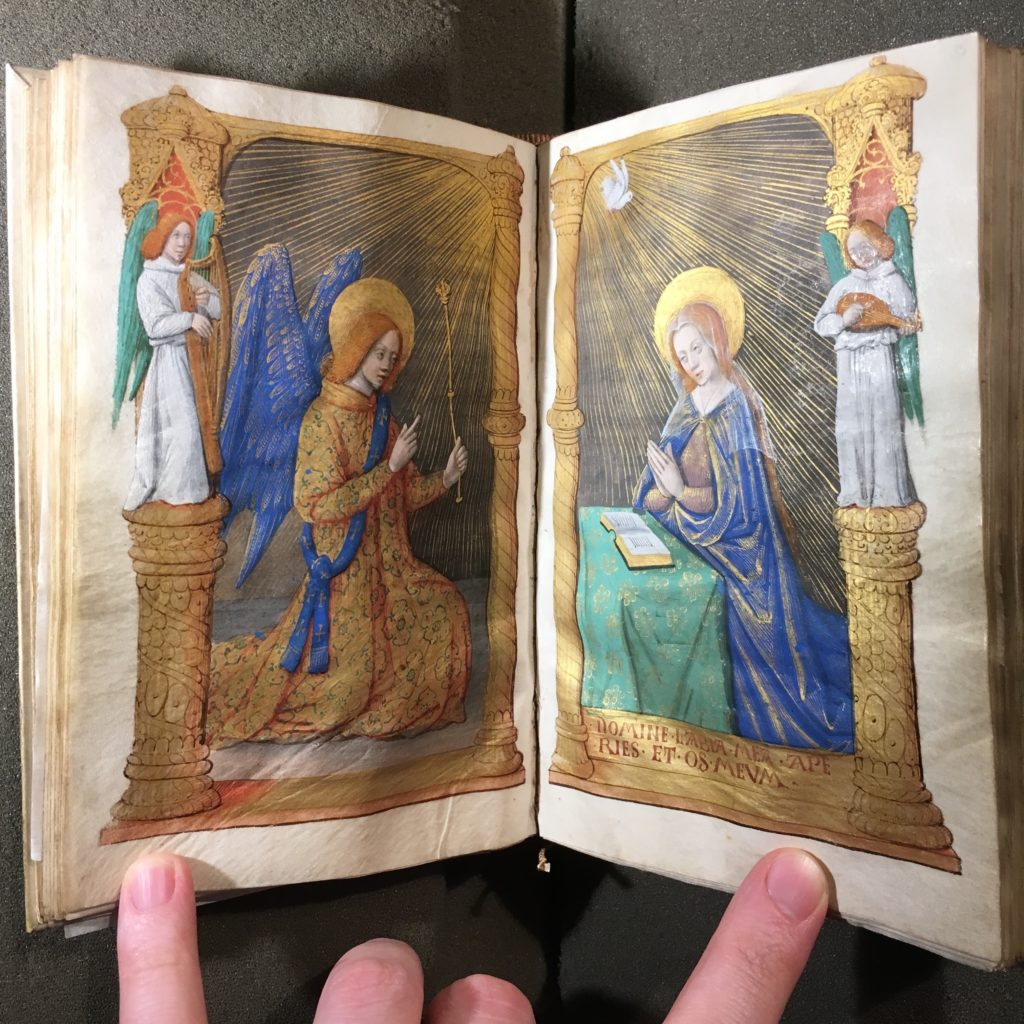
Unknown Bourges illuminator, Annunciation, Book of Hours for the Use of Bourges, France (Tours), ca. 1500, 16.5 x 10.5 cm (per folio), ink and pigment on parchment. Free Library of Philadelphia, Rare Book Department, gift of Anne Baker Lewis, 1936, acc. no. Lewis E 86, fols. 34v–35r. Image by author
In the Copenhagen and Petau Hours, certain images confront each other face-to-face, recalling the equally popular pictorial strategy of the “dramatic close-up,” whereby devotional iconography is brought radically forward towards the picture plane, usually on a single page only. This strategy has been considered as a sort of proto-cinematographic technique of late medieval visuality.[18] In the two Books of Hours, however, the images are cropped even more tightly and then matched in pairs, not for the benefit of a user’s affective piety, but for each other’s eyes only. The closest modern parallel is Bill Viola’s 1992 video installation Heaven and Earth, in which live television monitors face each other and nearly touch. The audience is accessory.
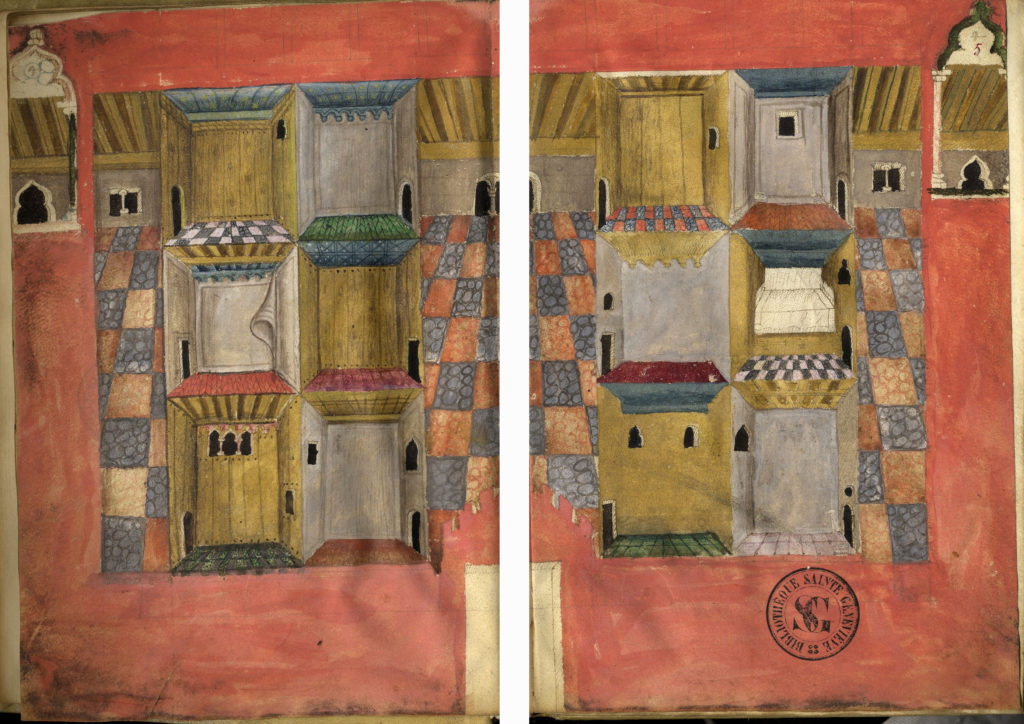
Unknown Italian illuminator, Memory Structure, Di l’artificial memoria, Italy, ca. 1450–1475, 21.8 x 15.0 cm (folio size), ink and pigment on parchment. Bibliothéque Sainte-Geneviéve, Paris, acc. no. Ms. 3368, fols. 4v–5r
In conventional examples of double-page imagery in the fifteenth and sixteenth centuries, the goal is to depict contiguous action transversally across an enlarged and unified picture plane, within a rationalized, perspectival space.[19] In a few exceptional cases within this already exceptional genre, the suggestion is less of a flattened, uniform view onto two halves of a joined Albertian architectonic space,[20] and more like the splayed, akimbo opening of a hinged dollhouse. Rarely if ever do protagonists in a scene themselves turn to face frontally, as this could compromise iconographic legibility. However, central, one-point perspectival recessions on both sides of the opening can strongly suggest a sliced-through, unfolded view of a building inside the book, as indeed the idea of the book as a built structure had deep roots (in microarchitectural treasure bindings) and a strong future (in architectural frontispieces). An unforgettable example is found in a unique treatise on memory training, a copy of Di l’artifitial memoria produced in mid-fifteenth-century northern Italy (fig. 19).[21] The unfinished illumination is hard to read, but it is clear that the loculi are deliberately left empty as places of mental projection, much like the landscapes devoid of figures in a curious French Book of Hours of the following century, recently discussed by Rebecca Zorach.[22] Even when the action appears to occur transversally, as in the presentation page from the Duc de Berry’s Brussels Hours (Bibliothèque royale de Belgique, Brussels, ms. 11060/61, fols. 10v–11r), which shows the Duke being presented by Saints Andrew and John the Baptist to the Virgin and Child, the parallel recession of the floor tiles can make it seem that we have swung the scene open, wedging ourselves in. Jan van Eyck (or a gifted associate) furthered the sense of the viewer breaking the “fourth wall” as they crack open the tome: in the Funeral Mass from the Turin-Milan Hours (Museo Civico, Turin, ms. 47, fol. 116r), the sheared masonry of the Gothic apse extends above the miniature’s frame, in the manner of a modern cutaway section.
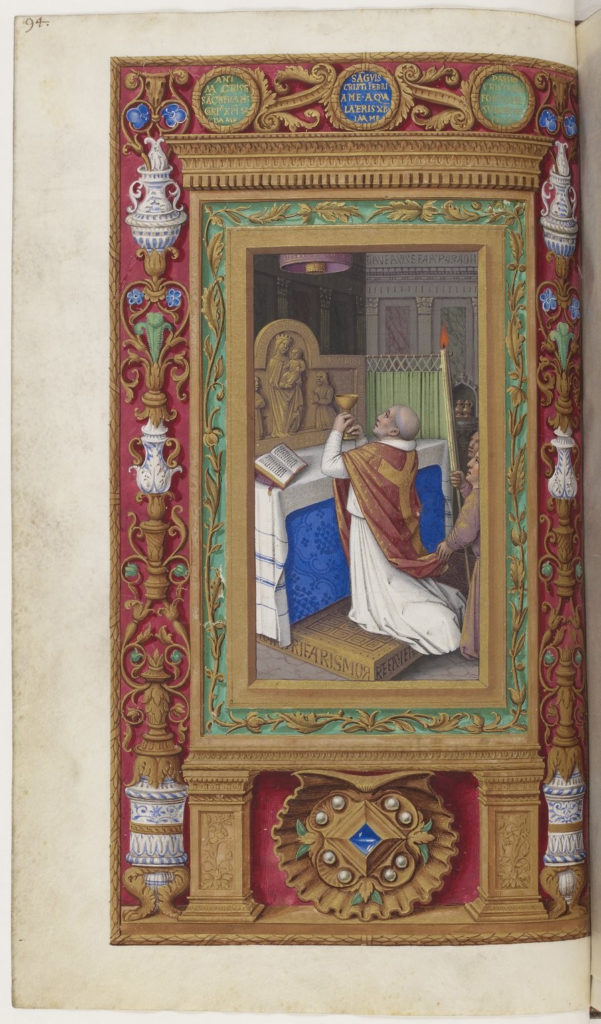
Miniatures: Jean Bourdichon (French, ca. 1457–1521) and Frame: Joan or Giovanni Todeschino (Italian, died ca. 1503), Elevation of the Chalice, Hours of Frederic of Aragon, France (Tours), 1503–1504, H: 24.5 x W: 15.5 cm, ink and pigment on parchment. Bibliothéque nationale de France, Paris, by 1830, acc. no. Ms. lat. 10532, p. 94
Returning to the Copenhagen and Petau Hours, we can observe that their precise layouts and decorative programs needed to be planned right from the scribal stage, something that is rare in even the most prestigious Books of Hours. Normally, even eminent artists like the illuminator Jean Fouquet (ca. 1420–1481) still had to grapple with the visual impediment posed by traditionally laid-out text, already completed by a scribe who usually had little or no foreknowledge of any customized decoration to come. However, one can hypothesize about how a patron in concert with a high-end painter-illuminator like Jean Poyer (a probable pupil of Fouquet) came up with such a novel idea in Tours around the year 1500.[23] Two important Books of Hours circulating in the region in exactly the same years—the lavish Flemish Book of Hours owned by Charles VIII known as La Flora and a sumptuous Book of Hours produced jointly by Joan Todeschino and Jean Bourdichon for the exiled king of Aragon Frederic III (fig. 20)—have miniatures seamlessly pasted into their folios using a passe-partout technique. The end result in the latter book is particularly subtle, with the seam running almost imperceptibly along the perimeter of the internal golden frame. Nevertheless, the leap from the empty window-frames visible as these books’ folios came together to a “holed” manuscript designed as such from the ground-up, is not such a great one.[24]
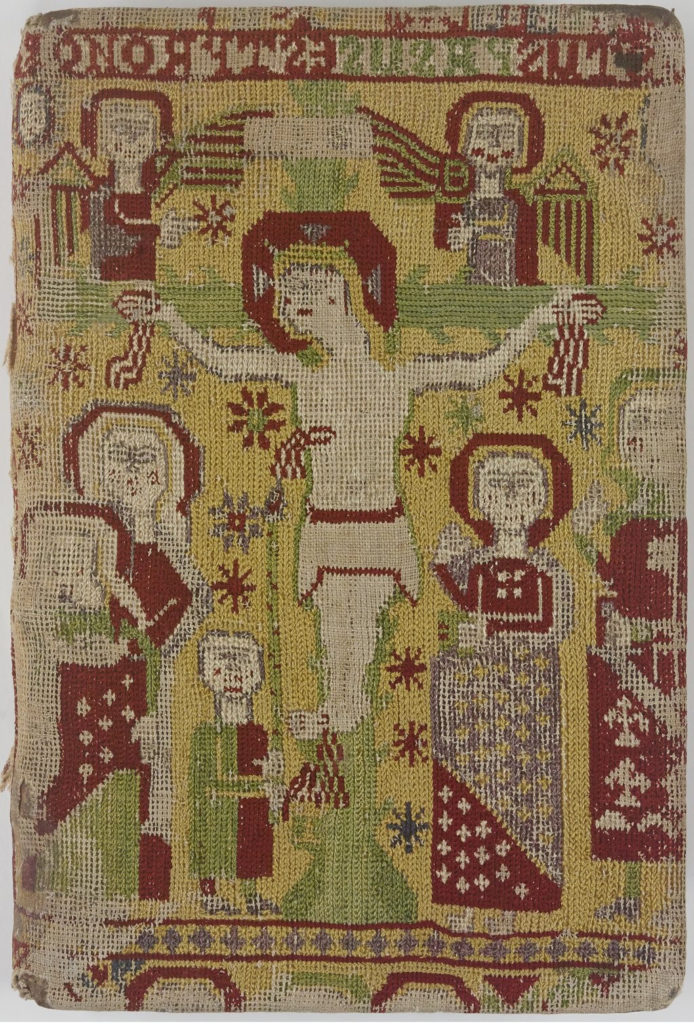
Jean Perréal (French, ca. 1455–1530), Exterior, Diptych with prayers and supposed portraits of Charles VIII and Anne of Brittany, France (Tours), ca. 1490–1495, approx H: 21.5 x W: 14.5 cm. Bibliothéque nationale de France, Paris, acc. no. Ms. lat. 1190
The solution achieved by the Petau and Copenhagen Hours seems so simple yet at the same time so semantically rich and rewarding. It allows for novel stagings of the relationship between pairs of images, and then the viewer, that seem to respond well to contemporary desiderata. Rather unsurprisingly, users of Books of Hours appear to have dwelt overwhelmingly on openings with miniatures, as art historian Kathryn Rudy’s work tracing historic patterns of finger dirt on manuscript margins has demonstrated.[25] Rudy’s findings are an earthy reminder that the ideal of imageless worship, so often vaunted in devotional manuals of the late Middle Ages, was seldom achieved in practice. The unique synthesis found in the Petau and Copenhagen Hours allowed for continuous reading and viewing in an almost miraculous way. It is a pity that such a solution was not employed more frequently. As an art historian, one can even think of countless present-day monographs with separate color plates that would benefit from this layout! And yet, the perforated folios of these horae allowed for a literally deeper level of engagement, not human-to-image, but image-to-image.

Jean Perréal, Exterior view of head/top, Diptych with prayers and supposed portraits of Charles VIII and Anne of Brittany, Bnf, acc. no. Ms. lat. 1190
The idea of depicted figures “facing off” between covers is made even more apparent in a unicum, twice as rare as the twin Poyer Hours but likewise produced in the 1490s, today in the Bibliothèque nationale de France.[26] When closed, this singularly unusual object outwardly resembles a slim prayer book, its boards covered in older, loom-woven fabric depicting the Crucifixion and other scenes from Christ’s Passion (fig. 21). On the spine, raised bands can be discerned under the fabric, concealing leather strap-hinges that hold the two sides of the object together. The recessed fore-edges, actually carved out of the same planks of wood as the covers, are gilded and tooled to resemble luxurious goffering (fig. 22). Once opened, the object until recently presented a single gathering of eight parchment folios loosely bound to its center (fig. 23). These contained excerpts from the Gospels and prayers to the Virgin Mary, but because they were considered extraneous by modern scholars, they were detached at some point in the mid-twentieth century to enhance the object’s presentation today as a diptych.
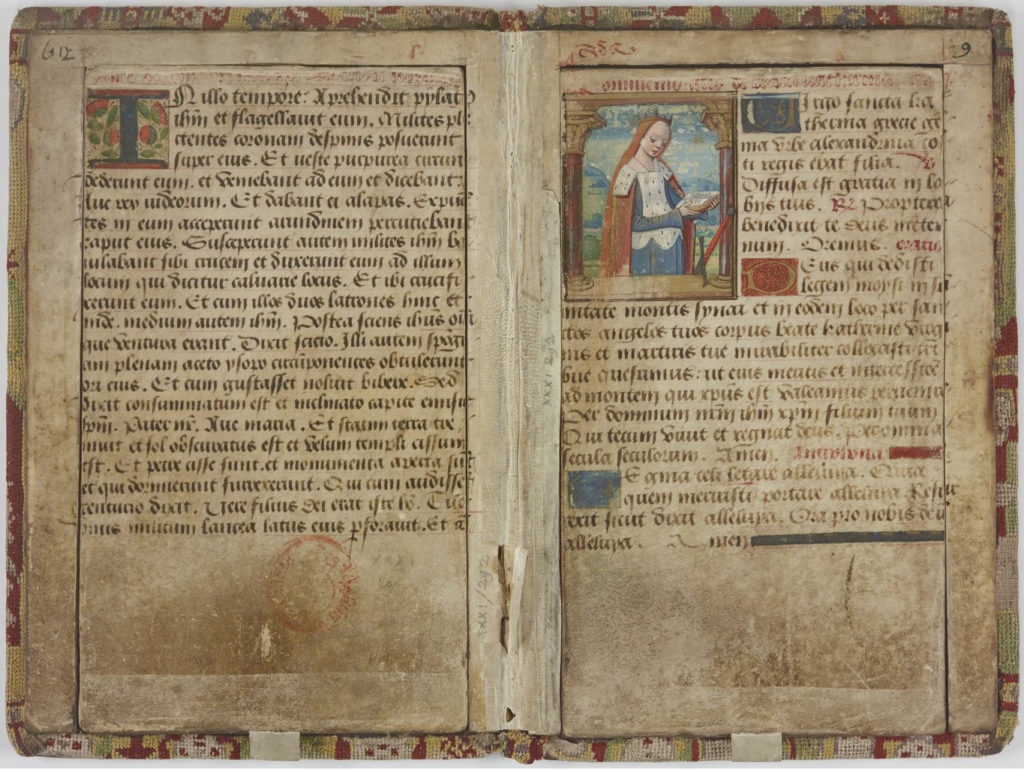
Jean Perréal, Interior, Diptych with prayers and supposed portraits of Charles VIII and Anne of Brittany, Bnf, acc. no.Ms. lat. 1190
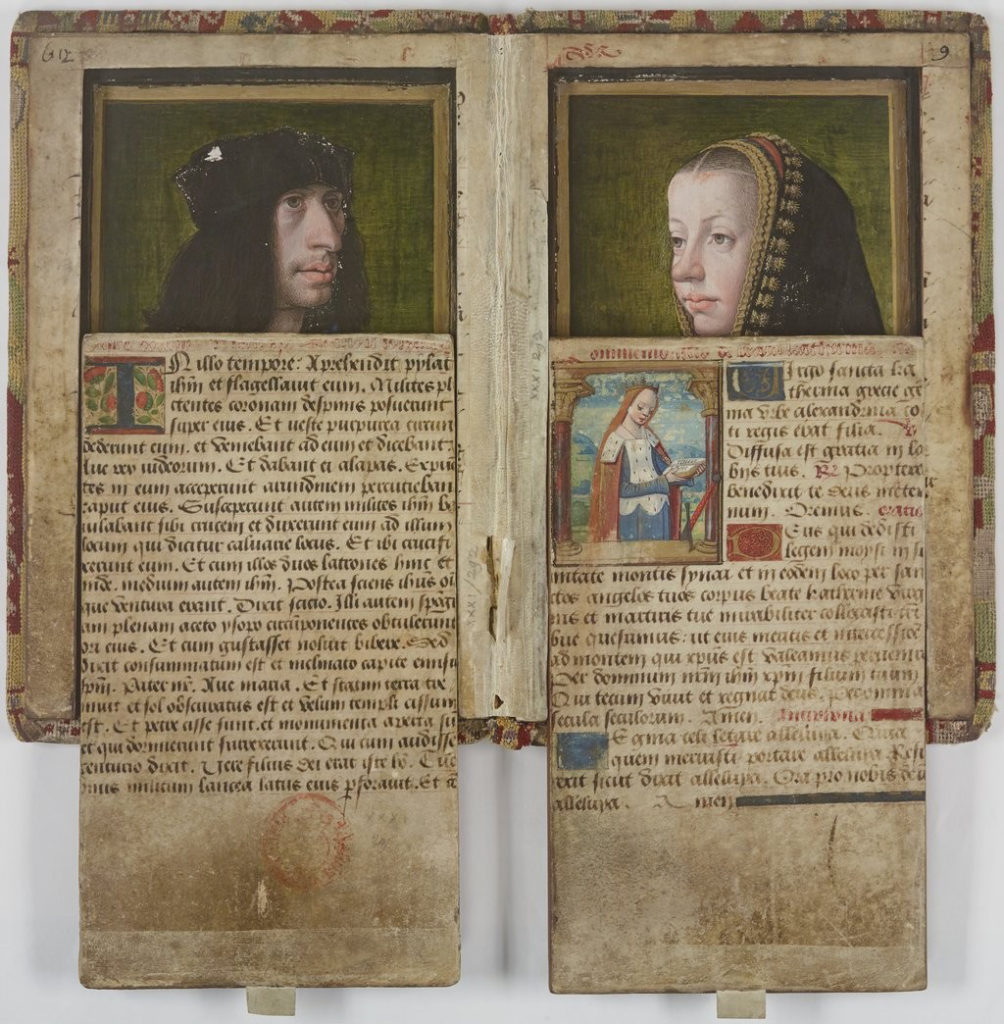
Jean Perréal, Interior, Diptych with prayers and supposed portraits of Charles VIII and Anne of Brittany, Bnf, acc. no.Ms. lat. 1190
The interior surfaces of the covers retain pasted-down prayers related to those of the central, withdrawn gathering, but their permanence is illusory (fig. 24): the parchment sheets are attached to thin wooden planks that slide down to reveal finely painted if somewhat caricatural portraits of a man and a woman, presumably a husband and wife (fig. 25). The action of uncovering recalls slightly later “peekaboo” books, notably an album of portrait roundels of fashionable Milanese ladies each covered by a hinged flap, created for Francis I, or a collection of French courtly likenesses that once had tabs playfully concealing the names of its subjects.[27] There is even an anticipation of prints with moveable parts.[28] The vivid likenesses in the Bibliothèque nationale item are however doubly hidden: firstly within a false book, and secondly behind retractable covers. Seemingly an oddity, such sliding covers were in fact more common in the early modern period than is apparent today, owing to the wholesale loss of original frames for most portraits: surviving examples of lidded portraits include Lorenzo Lotto’s Bernardo de’ Rossi (Capodimonte, Naples), now separated from its Allegory of Virtue and Vice lid (National Gallery of Art, Washington, DC), and Albrecht Dürer’s Hieronymous Holzschuher (Gemäldegalerie, Berlin). Archival and material evidence suggests that Renaissance portraits were stored, viewed, and handled more as tabletop objects (i.e., books) than as static pictures vertically hung.[29] While it is unclear at which point the prayers and indeed the fabric external covering may have been added to the Bibliothèque nationale diptych, the sliding mechanism is no doubt original. The object, in its current state, was already in the possession of the antiquarian Roger de Gaignières by 1711. This is therefore no nineteenth-century pastiche, and it seems likely that the prayers, which do not quite fit the panels and are rather crude in facture, were added by an early—perhaps original—owner, who felt the need to increase the devotional utility of a primarily secular, conjugal memento.
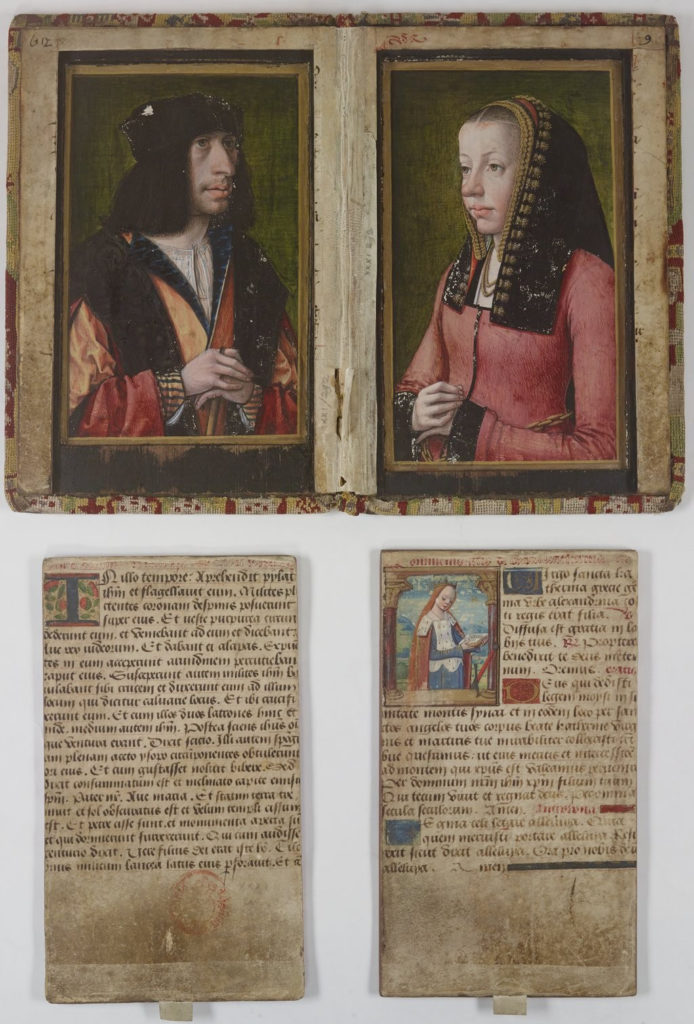
Jean Perréal, Interior with sliding portrait “lids” fully removed, Diptych with prayers and supposed portraits of Charles VIII and Anne of Brittany, Bnf, acc. no. Ms. lat. 1190
What conversations happened when the man and woman were doubly revealed or stowed away? The identity of the sitters has elicited a great deal of debate since the object was first published in the nineteenth century, as the man and woman closely resemble contemporary depictions of the French king Charles VIII and his wife Anne of Brittany, who married in 1491. The latest opinion is that the individuals are not royals but merely a fashionable contemporary couple from Lyon.[30] For our purposes, the identity of the sitters is rather less important than the immediate artistic context: newly open to the humanism permeating the French nobility on account of Charles VIII’s invasion of Naples in 1494, the intellectual atmosphere in Lyon privileged the creative combination of text and image.[31] Our object is a perfect representative of this erudite synthesis.
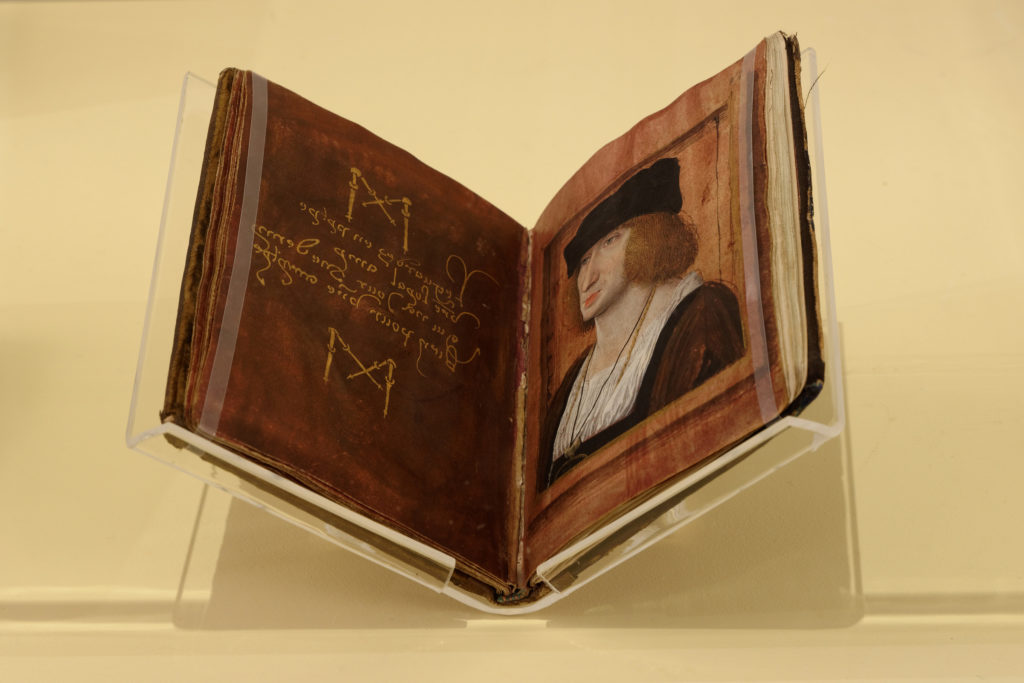
Jean Perréal (French, ca. 1455–1530), Portrait of Pierre Sala facing mirrored text, Petit livre d’amour, France (Lyon), ca. 1500, H: 13.0 x W: 9.5 cm (per folio), ink and pigment on parchment. British Library, London, 1883, acc. no. Stowe MS 955, fols. 16v–17r. Photograph by François de Dijon / Wikimedia Commons / CC BY-SA 4.0
The attribution of the portraits to the multitalented painter Jean Perréal (ca. 1455–1530), active in this burgeoning cosmopolitan center, is rather more secure. Perréal, a slightly younger contemporary of Jean Poyer, had an extraordinary career that included planning royal entries into the city of Lyon, designing tombs and advising on their appropriate sculptural materials, and writing poetry. But most of all, he produced other similarly scaled, intimate portraits on panel. Among his rare manuscript illuminations is a portrait of the French humanist Pierre Sala inserted at the end of a small album of enigmatic romantic poems dedicated to the latter’s paramour, Marguerite Bullioud (fig. 26).[32] The page facing the image of Sala bears a French quatrain written in mirrored lettering that translates as “look with pity upon your loyal friend, who has neither a day nor a half-day of wellness, for want of your love.” Text in the habitual reading direction generally serves as a prompt for a book’s reader to address an image, but here, through the reversed utterance, it is the image that speaks.[33] The text issues forth from Sala’s mouth, its beginning lining up with his visage precisely as the book is closed. This is the subject eye view of speech. Despite the obvious Leonardesque connotations of mirrored writing—and indeed Perréal had traveled to Italy and met Leonardo da Vinci on at least one occasion—writing issuing backwards (to us) from a painted figure has more immediate parallels in the most elevated religious iconography. Mary’s response to Gabriel is shown in this way in paradigmatic Annunciations, like the angel-finished image at the Servite church in Florence or that of the van Eyck brothers’ Ghent Altarpiece.[34] Christ’s commission to his mother at the Crucifixion, “Woman, behold thy son” (John 19:26), occasionally needs to be written backwards to avoid the potential for misdirection, since the Virgin Mary is invariably stationed to Christ’s right at the base of the Cross, and left-to-right reading would naturally lead to the sentence being misattributed to her.[35] Mirrored writing, too, is a well-known genre within the world of virtuoso Arabic calligraphy.[36]

Master of the Benson Portraits (French, active 1530–1550), Portrait of a Man and Portrait of a Woman (front and back), France, ca. 1540, H: 8.9 × W: 5.5 cm (per panel). Museum Mayer van den Bergh, Antwerp, acc. no.MMB.0187. © KIK-IRPA, Brussels
Returning to Perréal’s diptych, we can see the appeal of such a carefully conceived book-like object. In a closed diptych, the two sitters face each other and share an eternal bond. The similitude with the facing pages of a book is straightforward. Indeed, the structural limitations of rigid, framed panels could be overcome by reference to the more malleable codex: in a standard two-panel diptych, head-on figures could join together in virtual osculation, but the rebate of the frame would necessarily keep the two faces of the hinged object millimeters apart, locked in an air kiss. Pages in a codex touch literally, so much so that modern conservators sometimes interleave glassine for preservation purposes. The appeal to a book format was thus particularly apposite for husbands and wives, as in the Bibliothèque nationale object or another, slightly later diptych also disguised as a book (fig. 27), perhaps painted by an artist familiar with the recherché ambit of early-sixteenth-century Lyon.[37] In the latter, the subjects face forward quite insistently; by the looks of flattened modern photographs we’d be forgiven for thinking the man and woman glare out at us. When the diptych was closed (which was presumably a majority of the time), they would have stared each other down. In a different vein, Elizabeth of Austria (1526–1545) and Barbara Radziwiłł (1520 or 1523–1551), the two successive wives of Sigismund II Augustus of Poland (1520–1572), were represented in a dainty (17 x 12 cm) diptych wrapped, like the Bibliothèque nationale object, in a textile covering, augmented with expensive corner pieces and bosses of gilt silver appropriate only to a book (fig. 28).[38] A photograph with the diptych slightly folded inward, reflective of how it might actually have been witnessed, shows that their gazes meet each other’s, rather than ours. The presence of two consecutive wives, not uncommon in tomb sculpture, is here corralled into a living monument: Sigismund II outlived both consorts by over two decades, and so this must be imagined as a memento, with the widower meeting both women in the middle.
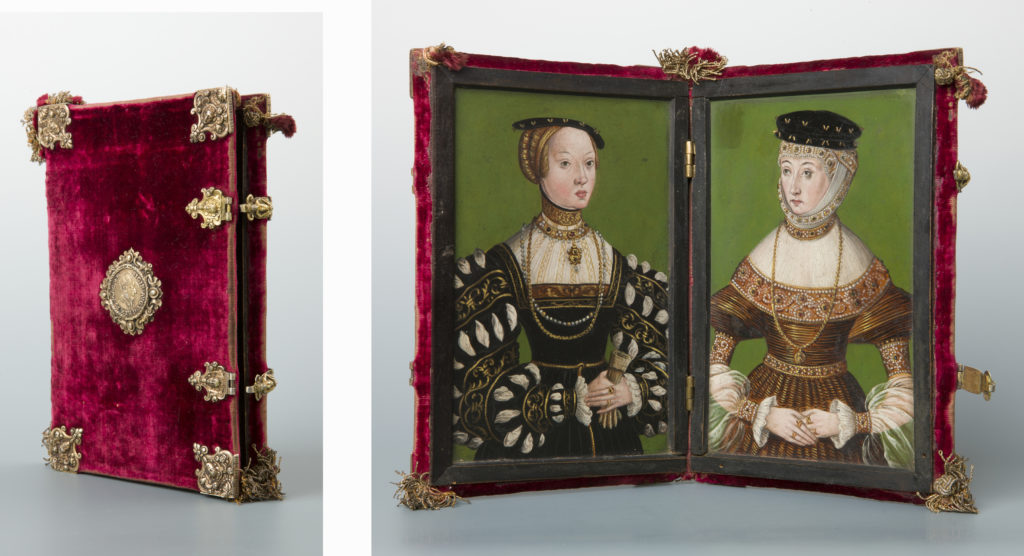
After Jacob Seisenegger (Austrian, 1505–1567), Exterior and interior, Diptych with portraits of Elizabeth of Austria and Barbara Radziwiłł, Poland, ca. 1540, H: 17.3 x W: 12.0 cm (per panel). Muzeum Naradowe w Krakowie, Krakow, acc. no. MNK IV-V-1433

Painter: Pietro Perugino (Italian, 1446–1523) and Binder: Unknown Italian (Florentine?), Interior and exterior, Diptych of Christ and the Virgin Mary, Italy (Florence), ca. 1495. Private collection, Italy
The unusual form of the bi-portrait pseudo-book could also function for pairs of closely associated divine personages. A diptych of Christ and the Virgin Mary painted by Pietro Perugino (ca. 1450‒1523) around 1495, now in a private collection, has an exterior covered by a tooled leather binding of Florentine facture, almost certainly integral to the object (fig. 29).[39] This diptych is essentially a page-less form of the bejeweled pendant-book that began our investigation. The poesis of Christ in dialogue with his mother, simultaneously understood as his mystic Virgin bride, has deep roots, and the interpretation of the Song of Songs as an exchange between the pair was widespread.[40] Earlier compositions, like a facing-page double portrait of Christ and the Virgin in a Psalter of about 1235, accompanied by Solomonic verses, make this abundantly clear (fig. 30). Yet the formula could work for other pairings. A sophisticated diptych ascribed to Jan van Eyck or his workshop, showing John the Baptist and the Virgin and Child exquisitely rendered not as flattened grisailles but as alabaster figurines, also has a striking frame carefully carved to resemble a handsomely bound book (fig. 31). While this feature was previously thought to be a significantly later alteration, recent technical analysis suggests it is original.[41] Indeed, the object makes most sense when it is considered as a unified illusionistic whole, pairing exterior deceits with interior faux-stone protagonists. Unlike other Eyckian grisaille compositions that show the action of the Annunciation traversing the pictorial space laterally, within a contiguous box extending behind the joined picture plane, here the Virgin faces forward and even the infant Christ’s gesture is foreshortened as if to suggest that it should meet the Lamb of God held by John the Baptist upon the closure of the panels.

Unknown German illuminator, Virgin Mary and Christ, Psalter, Germany (Hildesheim?), ca. 1235, H: 25 x W: 17.5 cm (per folio), ink and pigment on parchment. Württembergische Landesbibliothek, Stuttgart, acc. no. Codex Donaueschingen 309, fols. 33v–34r
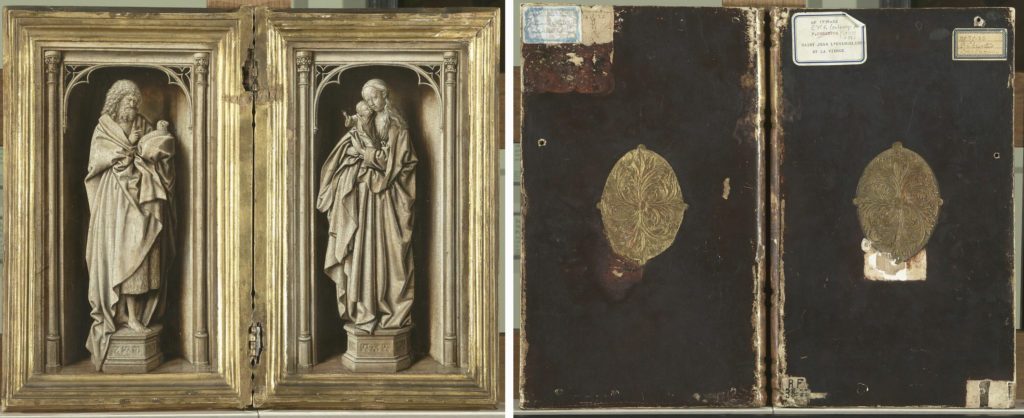
Workshop of Jan van Eyck (Belgian, 1390–1441), Diptych with Saints John the Baptist and the Virgin and Child, Belgium (Bruges), ca. 1440, 38.5 × 23.5 cm (per panel). Musée du Louvre, Paris, 1937, acc. no. RF 1938-22
Together with Perréal’s doubly hidden double portrait, these objects represent rare survivals of the many diptychs described as being “like a booke,” “in einem höltzern Libell,” or “fermans en manière de livre” in fourteenth-, fifteenth-, and sixteenth-century aristocratic inventories.[42] The incessant later re-framing and de-coupling of matched portraits, be they husband-and-wife or god-and-mother, has undoubtedly obliterated many more such contexts. Yet such items were intended to harness the powerful symbolism intrinsic to the book’s physical form: its contents could be cracked open for one or more viewers, or (more frequently) clasped shut. Metaphorically speaking, images and texts on facing planes could enter into dialogue with an external viewer, or be brought literally face-to-face when stowed. Alfred Acres has shown that artists of the period could subtly suggest visual linkages and continuities between both halves of a painted diptych, concluding that, “more often than not, it is we who are the middle of diptychs.” [43] And yet, the literal interface of the two sides is rarely remarked upon; when a diptych is closed, after all, there is nothing in the middle. Many discussions of late medieval devotional practice have centered on the role of the user/viewer in activating objects through prayer and repeated use; this naturally reflects the primarily ritual function of most pre-modern items we now consider to be works of art. But our insistence on human interlocutors as necessary prerequisites in the creation of meaning is an artifact of modern reader response theory. In the medieval era, many scenarios were assumed to produce meaning in the absence of human intervention: miraculous images, votive offerings, endowed memorial masses, even out-of-sight gargoyles. Closed books were another such case.
Fundamentally, all such book-like objects stem from the doubly unknowable archetype that was the block-like, fake wooden book (“livre contrefait”) gifted to the Duke of Berry by Paul de Limbourg and his two brothers on New Year’s day 1410–11.[44] Unknowable once over because the sole record of its existence is its rather terse description in two posthumous inventories of the Duke’s belongings (a similar faux-book, perhaps the same exact item, was recorded among the belongings of Margaret of Austria over a century later).[45] Unknowable a second time because even had it survived, its internal contents could, literally, only be imagined. Echoes of this special object, or at least the playful court aesthetic that led to its production, permeated the visual imagination of the following centuries. A book without pages is the ultimate prompt to wonder what goes on inside.
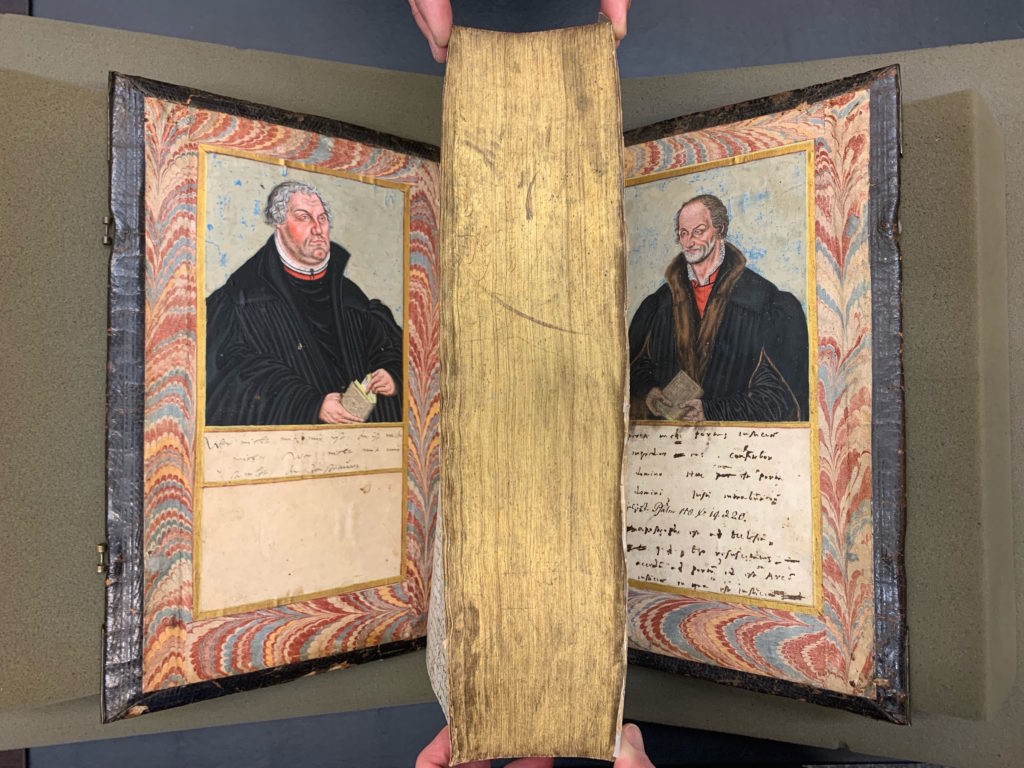
Attributed to Lucas Cranach the Younger (German, 1515–1586), Portraits of Martin Luther and Philipp Melanchthon on the upper and lower pastedowns, Biblia, das ist, Die gantze heilige Schrift (Wittemberg: Hans Lufft), Germany, 1565. University of Pennsylvania, Philadelphia, Kislak Center for Special Collections, Rare Books and Manuscripts, Rare Book Collection, acc. no. BS239 1565. Image by author
The colloquy of persons through a book or book-like thing is made clear by way of a final example, a 1565 German edition of a bible that is bracketed by two hand-painted miniatures on parchment pasted onto its front and back inside covers, respectively (fig. 32). The images, attributed to Lucas Cranach the younger, working after prototypes by his more famous father, depict Martin Luther and Philipp Melanchthon.[46] These two leaders of the Protestant Reformation are captioned by intriguing manuscript quotations that purport to be in their own handwriting, relics autograph as opposed to bodily. Luther proffers a vernacular, German rendering of Luke 11:23 (“He that is not with me, is against me; and he that gathereth not with me, scattereth”), while Melanchthon offers a mirrored riposte from the Vulgate: “Open ye to me the gates of justice: I will go into them, and give praise to the Lord. This is the gate of the Lord, the just shall enter into it.” (Psalm 117:19–20). While such verses could be broadly interpreted, they are well suited to the mechanics of the object to which they are appended. One must hold fast to Luther’s teachings as to Christ and the scriptures, like a board clasped to the text block—not scattered like a leaf in the wind. For Melanchthon, the swinging of a cover—a door—yields the metaphor of a book as a citadel to be entered. In its heft and its insistence on predestination, this Bible is a counterpoint to the tiny pendant with which we began, so dainty and conducive to salvific work. However, as new alpha and omega, the two caricatural reformers still hold on to their own books. Luther’s is open, while Melanchthon’s is closed, suggesting the start and end of an imaginary but imageless journey through the very thickness of the book.
[1] The mother-son diptych paradigm has deep, well-studied roots in late medieval European visual culture. See Otto Pächt, “The ‘Avignon Diptych’ and its Eastern Ancestry,” in Millard Meiss, ed., De Artibus Opuscula XL: Essays in Honor of Erwin Panofsky, (New York: New York University Press, 1961), 402–21; Wolfgang Kermer, Studien zum Diptychon in der sakralen Malerei: Von den Anfängen bis zur Mitte des sechzehnten Jahrhunderts (Düsseldorf: R. Stehle, 1967); Dagmar Eichberger, “Devotional Objects in Book Format: Diptychs in the Collection of Margaret of Austria and Her Family,” in Margaret M. Manion and Bernard J. Muir, eds., The Art of the Book: Its Place in Medieval Worship (Exeter: University of Exeter Press, 1998), 291–323; and Laura D. Gelfand, “The Devotional Portrait Diptych and the Manuscript Tradition,” in John Oliver Hand and Ron Spronk, eds., Essays in Context: Unfolding the Netherlandish Diptych (New Haven: Yale University Press, 2007), 46–59.
[2] For this phenomenon, see Marianne Koos, “Concealing and Revealing Pictures ‘in Small Volumes’: Portrait Miniatures and Their Envelopes,” Espacio, Tiempo y Forma: Historia del Arte, Serie VII, no. 6 (2018): 33–54, http://dx.doi.org/10.5944/etfvii.6.2018. For metal-leaf pendant books, see Romina Ebenhöch and Silke Tammen, “Wearing Devotional Books: Book-Shaped Miniature Pendants (Fifteenth to Sixteenth Centuries),” in David Ganz and Barbara Schellewald, eds., Clothing Sacred Scriptures: Book Art and Book Religion in Christian, Islamic, and Jewish Cultures (Boston: De Gruyter, 2018), 171–84, https://doi.org/10.1515/9783110558609-009.
[3] Jean-Pierre Suau, “Le thème du livre individuel des consciences sur les peintures murales méridionales du Jugement dernier, à la fin du Moyen Âge,” in Pierre Riom, ed., Enfer et paradis: L’au-delà dans l’art et la litterature en Europe (Conques: Le Centre, 1995), 147–75; see also Elizabeth Sandoval, “A Material Sign of Self: The Book as Metaphor and Representation in Fifteenth-Century Northern European Art” (PhD diss., Ohio State University, 2018).
[4] One of the few attempts to discuss this phenomenon, as it pertains to ninth- and tenth-century German illuminated manuscripts, is Wolfgang Christian Schneider, “Geschlossene Bücher–offene Bücher: Das Öffnen von Sinnräumen im Schließen der Codices,” Historische Zeitschrift 271, no. 3 (2000): 561–92; see also Wolfgang Christian Schneider, “Raum im Codex–Codex im Raum. Mittelalterliche Herrscher-Codices als virtuelle Interaktionsräume,” in Stephan Müller and Lieselotte Saurma-Jeltsch, eds., Codex und Raum (Wiesbaden: Harrassowitz, 2009), 127–84.
[5] For this phenomenon, see Nicholas Herman, “Excavating the Page: Virtuosity and Illusionism in Italian Book Illumination, 1460–1520,” Word & Image 27, no. 2 (2011): 190–211.
[6] This same manuscript (Krakow, Czartoryski Library, acc. no. Ms. 3025 I), also contains a marginal image of a small creature (a cat?) caught midway through a simulated tear in the folio, its rear end dangling in mid-air (pp. 469–70). For the manuscript, see Bałus Katarzyna Płonka, The Catalogue of Medieval Illuminated Manuscripts and Miniatures in the Princes Czartoryski Library and Museum (15th–16th Centuries) Pt. 1 (Krakow: Universitas, 2011), 62–79.
[7] See, respectively, Christine Sciacca, “Raising the Curtain on the Use of Textiles in Manuscripts,” in Kathryn M. Rudy and Barbara Baert, eds., Weaving, Veiling, and Dressing (Turnhout: Brepols, 2007), 161–90, https://doi.org/10.1484/M.MCS-EB.3.1875; Hanneke van Asperen, Silver Saints: Prayers and Badges in Late Medieval Books (Turnhout: Brepols, 2021), with previous bibliography; and Thomas DaCosta Kaufmann and Virginia Roehrig Kaufmann, “The Sanctification of Nature: Observations on the Origins of Trompe l’Oeil in Netherlandish Book Painting of the Fifteenth and Sixteenth Centuries,” J. Paul Getty Museum Journal 19 (1991): 43–64.
[8] Steph Cockroft, “Pocket Bible saved WWI soldier’s life—and still has the German bullet embedded in it just 50 pages from going all the way through and killing him,” The Daily Mail, January 16, 2021. https://www.dailymail.co.uk/news/article-4124620. Several instances of the same phenomenon have been reported in British and American newspapers over the decades.
[9] George M. Stratton, “The Mnemonic Feat of the ‘Shass Pollak,’” Psychological Review 24 (1917): 244–47. I thank Herbert Kessler for this reference.
[10] Garrett Stewart, Bookwork: Medium to Object to Concept to Art (Chicago: University of Chicago Press, 2011).
[11] Jaime Galbarro García, “Garcilaso de la Vega en cifras,” in Luis María Gómez Canseco, Juan Montero Delgado, and Pedro Ruiz Pérez, eds., Aurea Poesis: Estudios para Begoña López Bueno (Córdoba: Universidad de Córdoba, 2014), 67–70.
[12] Charles J. Mendelssohn, “Cardan on Cryptography,” Scripta Mathematica 6 (1939): 157–68.
[13] See Mindell Dubansky and Miriam Schaer, Blooks: The Art of Books That Aren’t. Book Objects from the Collection of Mindell Dubansky (New York: Grolier Club, 2016).
[14] or the Chansonnier, see the 2007 facsimile edition and the accompanying commentary in David Fallows, Chansonnier de Jean de Montchenu (ca. 1475): Commentary to the Facsimile of the Manuscript Rothschild 2973 (I.5.13) in the Bibliothèque Nationale de France (Valencia: Vicent García Editores, 2008).
[15] Cornelius Berthold, “The Word of God in One’s Hand: Touching and Holding Pendant Koran Manuscripts,” Das Mittelalter 25, no. 2 (2020): 338–57, https://doi.org/10.1515/mial-2020-0041.
[16] For contemporary examples inspired by this technique, see Martina D’Alton, Slash: Paper under the Knife (New York: Museum of Arts and Design, 2009).
[17] F. O. Büttner, “Besondere Redaktionen narrativer Ikonographie im Stundengebetbuch,” in Søren Kasperen, ed., Images of Cult and Devotion: Function and Reception of Christian Images in Medieval and post-Medieval Europe(Copenhagen: Museum Tusculanum Press, 2004), 89–148; Rostislav Tumanov, Das Kopenhagener Stundenbuch: Bildprogramm und Layout im Kontext spätmittelalterlicher Lektüre- und Andachtspraktiken (Cologne: Böhlau, 2017); Rostislav Tumanov, “Devotional Re-Enactment on the Way Through the Book: The Peculiar Layout of the Copenhagen Hours,” in David Ganz and Barbara Schellewald, eds., Clothing Sacred Scriptures: Book Art and Book Religion in Christian, Islamic, and Jewish Cultures (Boston: De Gruyter, 2018), 223–44; and Elina Gertsman, The Absent Image: Lacunae in Medieval Books (University Park: Pennsylvania State University Press, 2021).
[18] Sixten Ringbom, Icon to Narrative: The Rise of the Dramatic Close-up in Fifteenth-Century Devotional Painting (Åbo: Åbo akademi, 1965). For the “off-screen” narrative effect in religious imagery, see Lorenzo Pericolo, “The Invisible Presence: Cut-In, Close-Up, and Off-Scene in Antonello Da Messina’s Palermo Annunciate,” Representations 107, no. 1 (2009): 1–29.
[19] Jeffrey F. Hamburger, “Openings,” in G. C. Kratzmann, ed., Imagination, Books & Community in Medieval Europe: Papers of a Conference Held at the State Library of Victoria, Melbourne, Australia, 29–31 May, 2008 (South Yarra: Macmillan, 2009), 50–87.
[20] So-named after the influential Italian theorist Leon Battista Alberti (1404–1472), who codified the notion of the picture plane as an opening onto a cohesive space defined by receding linear perspective.
[21] See Federica Pich and Andrea Torre, eds., Di l’artifitial memoria: Ms. 3368 Bibliothèque Sainte-Geneviève di Parigi (Naples: La Stanza delle scritture, 2017) for a facsimile and commentary.
[22] This is in a private collection. See Rebecca Zorach, “‘Sweet in the Mouth, Bitter in the Belly’: Seeing Double in an Eccentric French Renaissance Book of Hours,” Art History 36, no. 5 (2013): 922–43.
[23] For Poyer (previously spelled Poyet), see Roger S. Wieck, William M. Voelkle, and K. Michelle Hearne, The Hours of Henry VIII: A Renaissance Masterpiece by Jean Poyet (New York: George Braziller, 2000); and Mara Hofmann, Jean Poyer: Das Gesamtwerk (Turnhout: Brepols, 2004).
[24] For La Flora (Naples, Biblioteca Nazionale Vittorio Emanuele III, acc. no. Ms. I.B.51), see Lieve De Kesel, “Use and Reuse of Manuscripts and Miniatures: Observations on Pasted-in, Recycled and Removed Miniatures and Text Leaves in Some Late Medieval Flemish Illuminated Manuscripts Related to La Flora,” Bulletin du bibliophile 1 (2011): 48–85; and Bodo Brinkmann, Die flämische Buchmalerei am Ende des Burgunderreichs: der Meister der Dresdener Gebetbuchs und die Miniaturisten seiner Zeit (Turnhout: Brepols, 1997), 209–11, 245–60. For the Hours of Frederic III of Aragon, see Teresa D’Urso, Giovanni Todeschino: La miniatura all’antica tra Venezia, Napoli e Tours (Naples: Arte Tipografica, 2007), 217–36.
[25] Kathryn M. Rudy, “Dirty Books: Quantifying Patterns of Use in Medieval Manuscripts Using a Densitometer,” Journal of Historians of Netherlandish Art 2, no. 1–2 (Summer 2010), https://doi.org/10.5092/jhna.2010.2.1.1.
[26] See the entry by Reynaud in François Avril and Nicole Reynaud, Les Manuscrits à peintures en France, 1440–1520 (Paris: Flammarion, 1993), 366–68, cat. 206.
[27] Francis I’s album, produced by the obscure artist Giovanni Ambrogio Noceto, is in the Biblioteca Trivulziana, Milan, acc. no. ms. 2159. See Giulia Bologna, Tutte le dame del re: ritratti di dame milanesi per Francesco I re di Francia (Milan: Biblioteca Trivulziana, 1989); Stephanie Buck, “Beauty and Virtue for Francis I: Iohannes Ambrosius Nucetus and the Early Portrait Miniature,” Journal of the Warburg and Courtauld Institutes 71 (2008): 191–210; John Gagné, “Collecting Women: Three French Kings and Manuscripts of Empire in the Italian Wars,” I Tatti Studies in the Italian Renaissance 20, no. 1 (2017): 161–78. The collection of portraits is in the Bibliothèque Méjanes, Aix-en-Provence, acc. no. ms. 442, Portraits de François Ier et des princes, princesses and personnes notables de la Cour (1525–27). See Gagné, “Collecting Women,” 167–70. A late-sixteenth-century Italian costume book at The Walters Art Museum, acc. no. W.477, contains several such “peekaboo” flaps.
[28] Suzanne Karr Schmidt, Interactive and Sculptural Printmaking in the Renaissance (Boston: Brill, 2018).
[29] Angelica Dülberg, Privatporträts: Geschichte und Ikonologie einer Gattung im 15. und 16. Jahrhundert (Berlin: Mann, 1990).
[30] See, with comprehensive earlier bibliography, the entry by Martha Wolff in Geneviève Bresc-Bautier et al., eds., France 1500: Entre Moyen Age et Renaissance (Paris: Editions de la Réunion des musées nationaux, 2010), 110–11, cat. 34.
[31] Ludmila Virassamynaïken, ed., Lyon Renaissance: Arts et Humanisme (Paris: Somogy, 2015).
[32] See Paola Cifarelli, “Pierre Sala et Le Petit Livre d’Amour (Manuscrit Londres, BL, Stowe MS 955),” in Tania Van Hemelryck and Stefania Marzano, eds., Le Recueil Au Moyen Âge (Turnhout: Brepols, 2010), 61–77, http://www.brepolsonline.net/doi/abs/10.1484/M.TCC-EB.3.4008.
[33] Ulrich Pfisterer, “Mirrors of Love and Creativity around 1500,” in Renaissance Love: Eros, Passion, and Friendship in Italian Art Around 1500, ed. in Jeanette Kohl, Marianne Koos, and Adrian W. B. Randolph, eds., Renaissance Love: Eros, Passion, and Friendship in Italian Art Around 1500 (Berlin: Deutscher Kunstverlag, 2014), 185–94.
[34] Penny Howell Jolly, “Jan van Eyck’s Italian Pilgrimage: A Miraculous Florentine Annunciation and the Ghent Altarpiece,” Zeitschrift Für Kunstgeschichte 61 (1998): 369–94.
[35] See, for example, a panel by Lorenzo di Bicci of ca. 1400 in the Allentown Art Museum, acc. no. 1960.022.000.
[36] Esra Akin, Muthanna/Mirror Writing in Islamic Calligraphy: History, Theory, and Aesthetics (Bloomington: Indiana University Press, 2020).
[37] See John Oliver Hand, Catherine Metzger, and Ron Spronk, Prayers and Portraits: Unfolding the Netherlandish Diptych (New Haven: Yale University Press, 2006), 126–29, cat. 18; and 285.
[38] See Dülberg, Privatporträts, nos. 272–73 and 275, figs. 27‒28.
[39] See Francesco Federico Mancini, Perugino inedito a Campione d’Italia: Quattro tavolette e un dittico (Campione d’Italia: Comune di Campione d’Italia, 2012), 61–93. The bindings have been likened to those illustrated in Tammaro De Marinis, La legatura artistica in Italia nei secoli XV e XVI: Notizie ed elenchi, Vol. 1 (Florence: Alinari, 1960), 109, nos. 1093–1094; and 112, no. 1132.
[40] See Donal Flanagan, “Mary, Bride of Christ,” Irish Theological Quarterly 28, no. 3 (1962): 233–37, https://doi.org/10.1177/002114006202800304; and Luigi Gambero, Mary and the Fathers of the Church: The Blessed Virgin Mary in Patristic Thought, trans. Thomas Buffer (San Francisco: Ignatius Press, 1999), 117–19.
[41] Hélène Verougstraete and Roger van Schoute, “Frames and Supports of Some Eyckian Paintings,” in Susan Foister and Delphine Cool, eds., Investigating Jan van Eyck (Turnhout: Brepols, 2000), 112–15.
[42] For this genre of object, see Eichberger, “Devotional Objects in Book Format.”
[43] Alfred Acres, “The Middle of Diptychs,” in Sarah Blick and Laura Gelfand, eds., Push Me, Pull You: Imaginative, Emotional, Physical, and Spatial Interaction in Late Medieval and Renaissance Art, Studies in Medieval and Reformation Traditions 156.1 (Leiden: Brill, 2011), 595–622.
[44] Inventaire des joyaux, livres, etc. de Jean Duc de Berry (1413–1416). Paris, BnF, acc. no. KK 258, fol. 162v, in the section labeled “livres donnés au duc.” The item was “prisé 50 sous tournois” in the corresponding entry number 1130 in the inventory, which is now in Paris, Bibliothèque Sainte Geneviève, acc. no. ms. 841. See Léopold Delisle, Le cabinet des manuscrits de la Bibliothèque impériale: Étude sur la formation de ce dépot, comprenant les éléments d’une histoire de la calligraphie, de la miniature, de la reliure, et du commerce des livres à Paris avant l’invention de l’imprimerie, vol. 3 (Paris: Imprimerie impériale, 1881), 194, no. 297. See also Jules Guiffrey, Inventaires de Jean duc de Berry (1401–1416) publiés et annotés par Jules Guiffrey, vol. 1 (Paris: E. Leroux, 1894), 265, no. 994; and Jan Hirschbiegel, Étrennes: Untersuchungen zum höfischen Geschenkverkehr im spätmittelalterlichen Frankreich der Zeit Karls VI. (1380–1422) (Munich: De Gruyter Oldenbourg, 2003), nos. 1507, 1537, and 1681.
[45] Inventaire original des joyaux, tapisseries, livres et vaisselle de l’archiduchesse Marguerite I d’ Autriche, à Malines (1523–1524), in a section entitled “La seconde chambre à chemynée,” in Paris, BnF, acc. no. Cinq cents de Colbert 128, fol. 69v; and Léon de Laborde, “Inventaire des tableaux, livres, joyaux et meubles de Marguerite d’Autriche,” Revue Archéologique 7, no. 1 (1850): 22, no. 106.
[46] The sole short publication on this item is A. Haikin, “Investigating Two Cranach Miniatures,” The Book Collector 50, no. 3 (2001): 365–77.
